

Yosemite Itinerary: Ultimate First Time Visitor Guide (1, 2 & 3 Day Itinerary)
by Mark and Kristen Morgan
Published: July 29, 2020
UPDATED: May 21, 2024
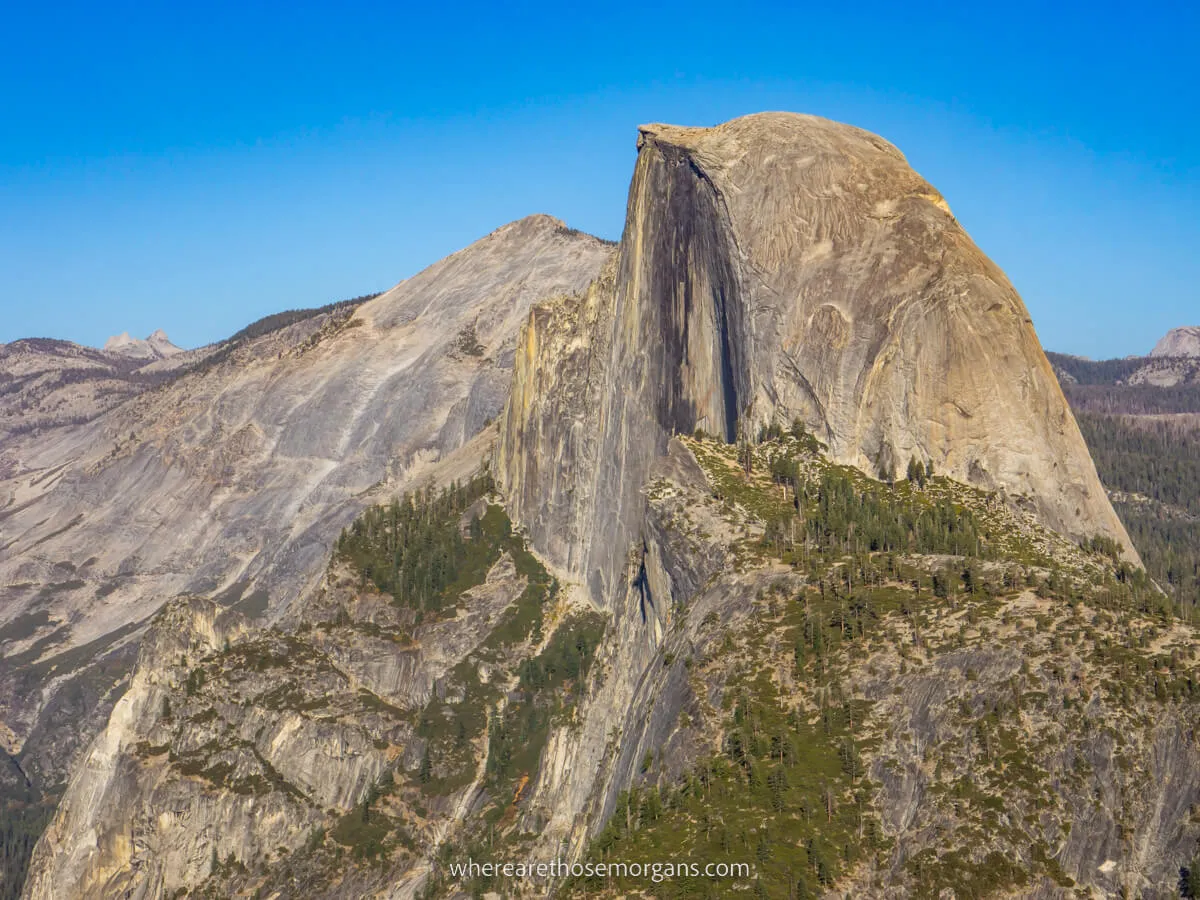
Yosemite is a treasure trove of beauty and one of the crown jewels among the very best USA National Parks . This Yosemite itinerary will help you plan the most efficient way to spend your time in this spectacular corner of California.
The spellbinding awe of Yosemite’s landscapes, smooth domed rock formations and unspeakably majestic valley have to be seen in person to be believed.
We will show you the best way to spend 1, 2 and 3 days at Yosemite to cover day trips, weekend breaks and those fortunate to have an extra day.
No matter how long you spend here, we know you will be swept off your feet – just like the great writers and photographers who immortalized Yosemite before you.
Why Visit Yosemite National Park?
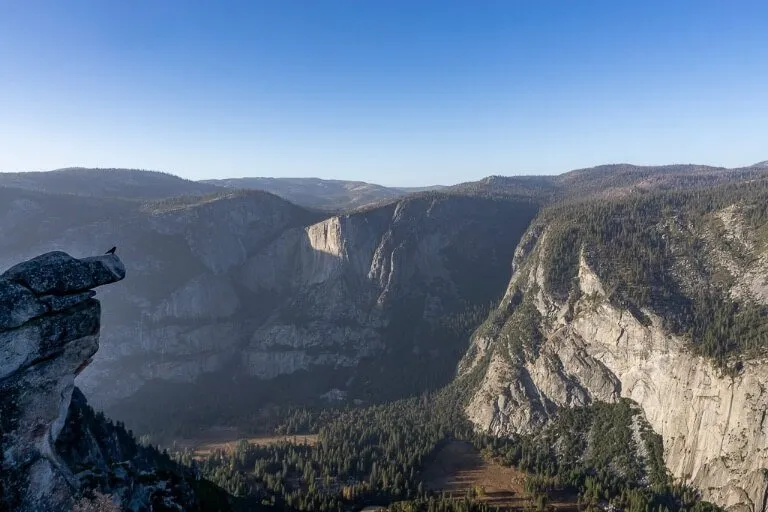
Yellowstone is arguably the King of US National Parks – being the first established and immensely popular – but every King needs a Queen and Yosemite National Park’s astonishing grandeur is regal enough for our vote .
The park has something for everyone, from family vacations and couples who love hiking , to expert rock climbers and pro photographers.
Beloved panoramas of sweeping valleys, waterfalls and famous granite monoliths steal the show at Yosemite. Photography enthusiasts will be blown away.
El Capitan and Half Dome are even more impressive than you imagine but simply driving through Yosemite valley is scenic enough to justify a visit.
Various stop-off points around the valley scenic loop road are perfect for the less able or young children.
Yosemite is the gift that keeps on giving. It also happens to be a hikers paradise with hundreds of epic miles of trails with awe-inspiring climaxes to spur you on.
In summary, you should visit Yosemite National Park in California because it is a natural wonder perfect for everyone!
Yosemite National Park Factfile
Address : PO Box 577, Yosemite National Park, CA 95389 Website : nps.gov/yose Phone : (209) 372-0200 Park Hours : All day, every day Entrance Fee : US$ 35 Vehicle 7 Day Pass (or free with America the Beautiful Pass ) Campgrounds : Yes, spread across the park (see campgrounds) Accommodation : Notoriously challenging, some lodging in Yosemite Valley, more in surrounding areas Backcountry camping : Backcountry Use Permit Required Top Activities : Hiking, Camping, Rock Climbing, Stargazing, photography Annual Visitors : 4.5 million
How To Get To Yosemite National Park
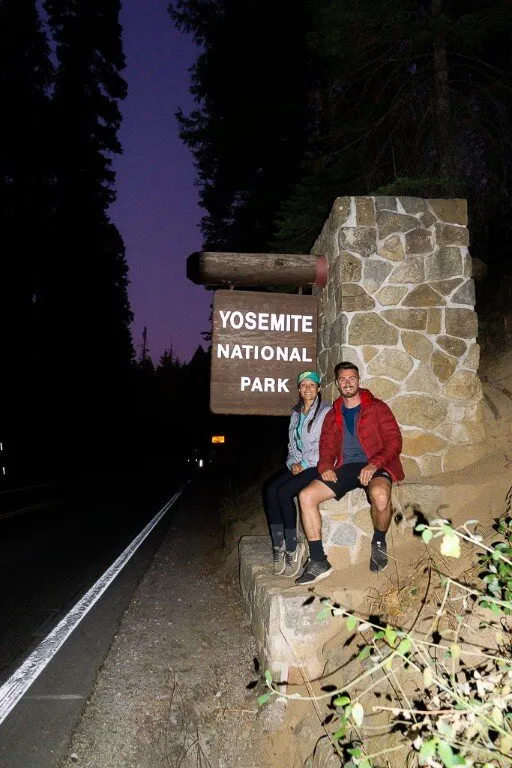
Flying / Closest Airports to Yosemite
Smaller – Fresno-Yosemite International, Merced and Modesto airports are all under 3 hours drive from the National Park.
Larger – San Francisco, Oakland, San Jose, Sacramento and Reno-Tahoe airports are all under 5 hours drive. More flights and of course the only options for those traveling from further afield.
- We always use and recommend searching for flights with Skyscanner for best prices, options and user experience.
- If you plan to hire a car and drive to Yosemite, compare prices and options with Rental Cars for best value.
Related : Save money with our 15 expert tips on finding cheap flights
Driving Entrances to Yosemite
There are a total of 5 entrances to Yosemite National Park but we will focus on the 4 with access to Yosemite Valley.
Tioga Pass Entrance (East, only open May-October, crosses Sierra Nevada); Big Oak Flat Entrance (Northwest); Arch Rock Entrance (Southwest) and South Entrance (South).
Hetch Hetchy is the 5th entrance to park boundaries but it is a secluded and does not lead to the main Yosemite attractions.
- Los Angeles, Sequoia, Kings Canyon, Joshua Tree and San Diego – enter via Fresno and South Entrance
- San Jose – enter via Arch Rock entrance
- San Francisco and Oakland – enter via either Arch Rock Entrance or Big Oak Flat Entrance
- Sacramento (and North to Oregon/Washington) – enter via Big Oak Flat Entrance
- Reno, Las Vegas, Death Valley (and East to all US) – enter via Tioga Pass Entrance (May-Oct)
Read about the best things to do in San Francisco , Los Angeles and San Diego to help plan your California road trip.
Public Transport Options to Yosemite
Amtrak offer a train/bus combination from most major cities around California. Be aware there could be a number of transfers and it will take between 5-7 hours from San Francisco.
Alternatively, you can book a greyhound to Merced and hop on a Yosemite Area Regional Transportation System (YARTS).
This would pass though Mariposa, Midpines and El Portal (all places you might be forced to stay in Summer with lack of accommodation options) and enter via Arch Rock.
YARTS also runs services from Sonora (Big Oak Flat entrance), Mammoth Lakes (Tioga Pass entrance) and Fresno (South entrance). More information on YARTS .
Yosemite Valley Shuttle
Yosemite provides a free shuttle bus which loops around the valley regularly, saving on congestion and pollution.
Especially in Summer, you will need to arrive very early and if you are fortunate enough to find a parking space near Yosemite village, do not move your car until you are ready to leave!
Take the shuttle bus that you can hop on – hop off at each stop.
Need help planning your trip to Yosemite?
Our popular Yosemite travel guidebook helps you with planning every aspect of your visit, including what to see, the best hikes, where to eat and stay, itinerary ideas and map!
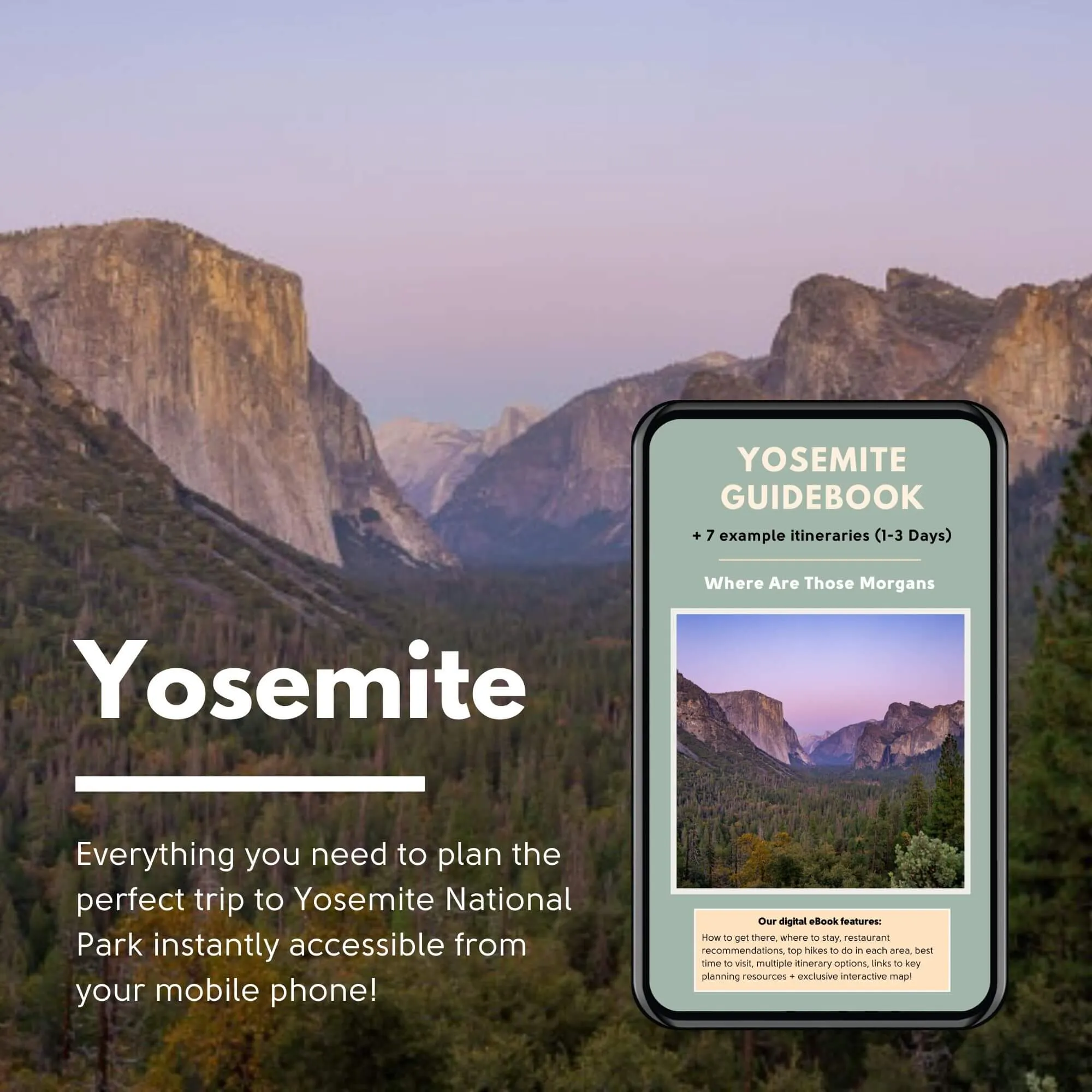
Best Time To Visit Yosemite National Park
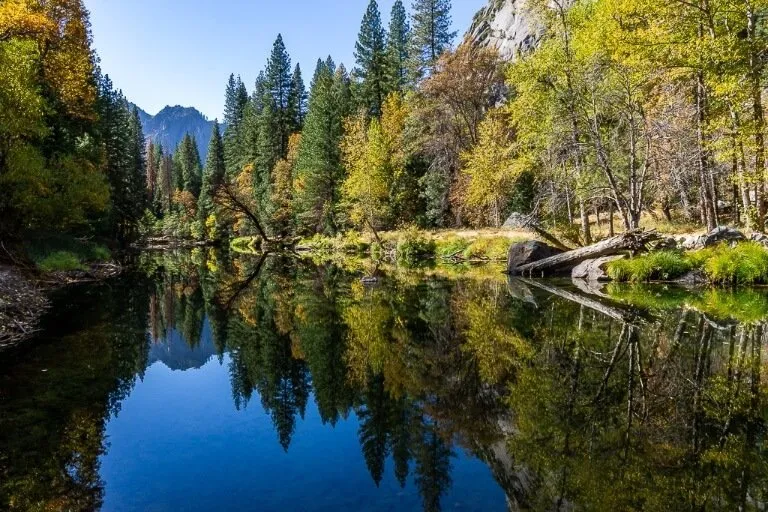
Close your eyes and point to an annual calendar … it doesn’t matter which date you choose, Yosemite is going to blow you away. Every season offers its own unique take on the park and you will have to compromise one thing for another.
Summer is renowned for being unbearably packed so we advise if possible to plan your Yosemite itinerary in Spring or Fall.
- Spring – The best time to visit for waterfalls in full flow, spring bloom, fewer crowds than Summer, will need layers for hot/cold/hiking.
- Summer – Slightly longer daylight hours, warmer weather, overcrowding problem, busy trails, traffic jams, book accommodation way in advance to stand a chance.
- Fall – Gorgeous autumnal foliage colors, barely any water flowing, comfortable temperatures and crowd levels, layers required.
- Winter – Unique time to visit Yosemite with Skiing, Ice Skating and Snowshoeing very popular. Expect fewer crowds, stunning winter wonderland scenery and cold weather.
We first visited Yosemite National Park in October at the heart of the Fall season and like many places in the US at this time of year, it was beautiful. However, we were (extremely!) disappointed the postcard perfect waterfalls were bone dry.
But hey, that’s the trade off. And you can see how pretty the autumnal foliage is in this Yosemite itinerary. Next time we will visit in Spring!
Best Things To Do In Yosemite National Park
The overwhelming majority of best things for you to do on your Yosemite itinerary are within Yosemite Valley itself. However, there are other amazing places to explore away from the valley that are far less crowded.
Here are some of the top highlights for you to consider in Yosemite:
Half Dome Hike
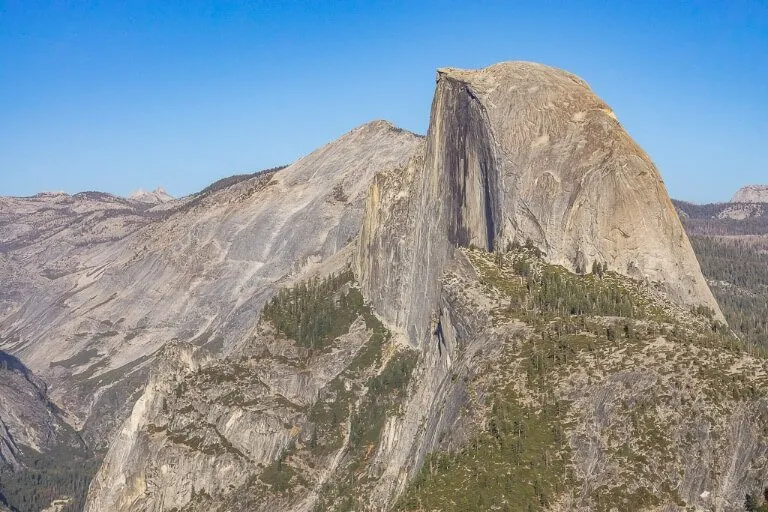
Half Dome is Yosemite’s iconic granite dome at the far end of the valley appearing as though a meat cleaver sliced it precisely in half.
Standing proudly at just under 5,000 feet above Yosemite Valley and dominating most nearby viewpoints, Half Dome is one of the most sought after and amazing hikes in the world.
What was once considered inaccessible can now be accessed by multiple rock climbing routes and one hiking path. This hiking path is only open between Memorial Day and Columbus Day (May-Oct) and is not for the feint hearted.
Cables are inserted each May to aid hikers with the final stretch to Half Dome summit and it is steep. Extremely steep.
Many take this hike on and have to be assisted by park rangers each year because they underestimated either its difficulty or they were afraid of heights.
Half Dome Lottery Permit
In order to summit Half Dome, you will need a permit and they are not easy to acquire. To be in with a chance, you have to enter a lottery in March for the upcoming season. Only 300 hikers are permitted to summit Half Dome per day, consisting of 225 day hikers and 75 backpackers.
You can apply for up to 6 people and you can only apply once.
If you are successful, you will become the permit holder and everyone else in your party become alternates. This is important because the permit holder must be present on the day for any of the group to summit.
If you are unsuccessful, you can take your chances by applying for a permit in the daily lottery. You can apply 2 days before the date you want to hike Half Dome.
For example, you apply on Monday to hike on Wednesday. You find out the same day if you are successful. Read NPS guidelines for Half Dome to plan your hike.
Half Dome is one of the best hikes in the world but it isn’t easy. To reach the base of Half Dome, you can either take:
- John Muir trail (longer but more gradual) at 16.4 miles roundtrip
- Mist trail at 14 miles roundtrip (shorter but steeper)
- Or a combination of both trails in a loop
Most people take between 10-12 hours total time for this round trip route to Half Dome summit.
Leave at sunrise and give yourself / your group a non negotiable turn around time. For example, if you haven’t summited by 2pm, turn around.
Check Yosemite sunrise times before your visit.
The Mist Trail / John Muir Trail Loop
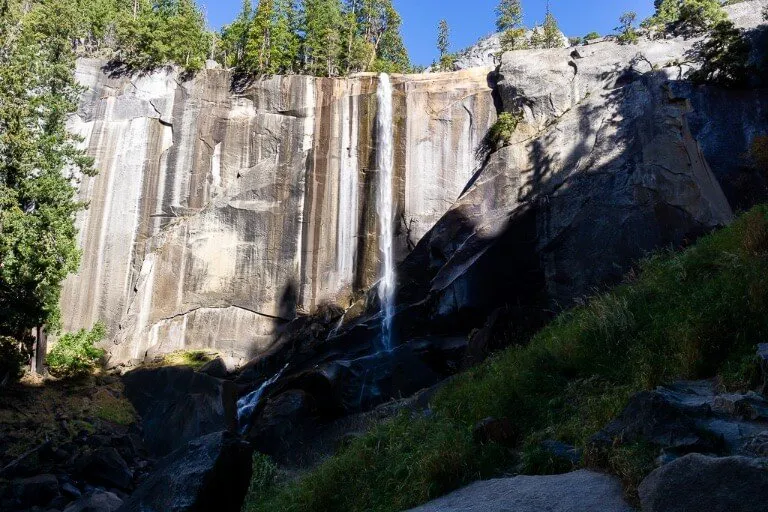
Half Dome is the quintessential Yosemite hike but don’t sweat it if you can’t get a permit or you visit out of season. Yosemite has a ton of awesome alternatives and here’s something to remember:
You can’t see Half Dome from the top of Half Dome!!
Mist trail is Yosemite’s signature hike and therefore the most crowded trail in the park. You will pass two of Yosemite’s rock-star status waterfalls in Vernal Falls and Nevada Falls on this fantastic hike.
Views over Yosemite Valley and the back of Half Dome from Nevada Falls are worth the effort.
- Trail Distance : 7 miles roundtrip / 8 miles roundtrip Mist up, John Muir down loop (add on 1.5 miles roundtrip if walking from Curry village and not taking park shuttle to trailhead)
- Elevation Gain : 1,900 feet to Nevada Falls
- Trail Time : 4-6 hours if loop completed
- Trail Difficulty : Moderate / Strenuous
In peak season or weekends through Spring/Fall be sure to set off either very early or later in the afternoon to avoid the mid-morning rush.
Read our complete Yosemite Mist Trail hiking guide to learn more, featuring John Muir Loop, Vernal and Nevada Fall, maps and tips to help plan your hike.
Bridalveil Fall
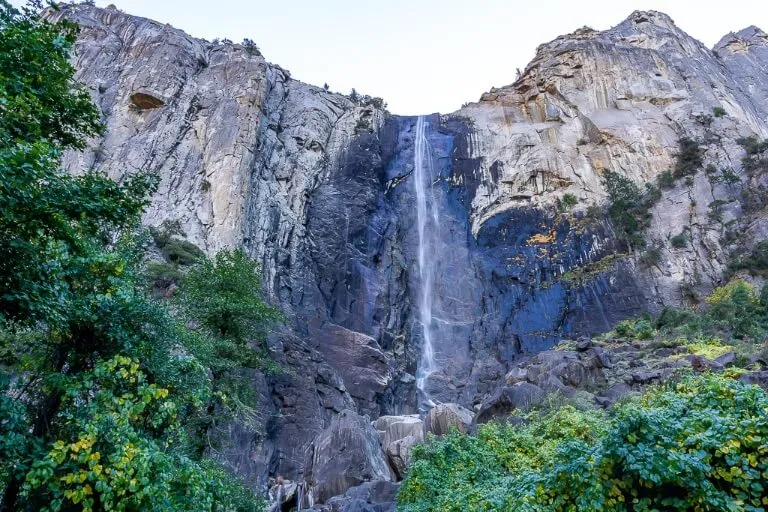
Bridalveil Fall will be the very first waterfall you see as you enter Yosemite Valley. It is the iconic waterfall to the right of famous valley images taken in Spring when the fall thunders.
During Summer and Fall Bridalveil Fall is wispy and a light spray trickles from 189 meters above a viewing area.
The trail is just 0.5 miles roundtrip close to a car park which makes it perfect for young children or those with less able family members.
Yosemite Falls
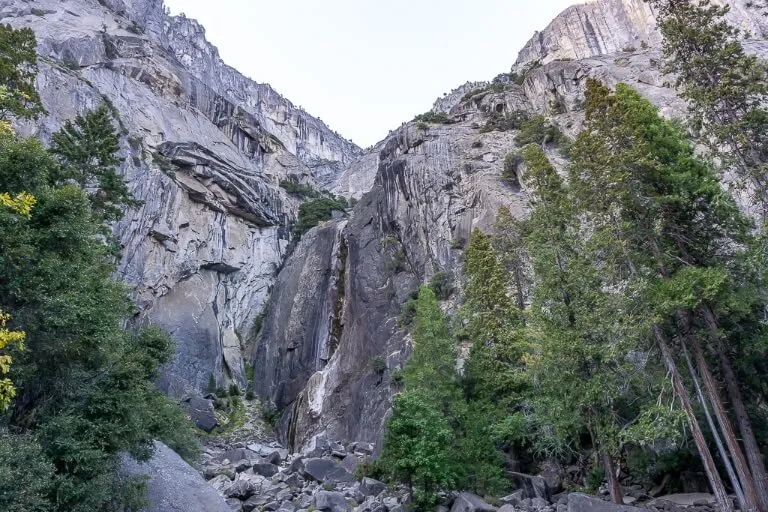
The mighty Yosemite Falls is the tallest waterfall in North America and the fifth tallest in the world.
However, you will only see water here between November and July – as you can see in our photo above taken in October the falls were bone dry.
You can hike to Lower Yosemite Falls, an easy 1 mile flat round trip trail (where the photo above was taken) or hike a strenuous 6-8 hour / 7 mile roundtrip trail to Upper Yosemite Falls.
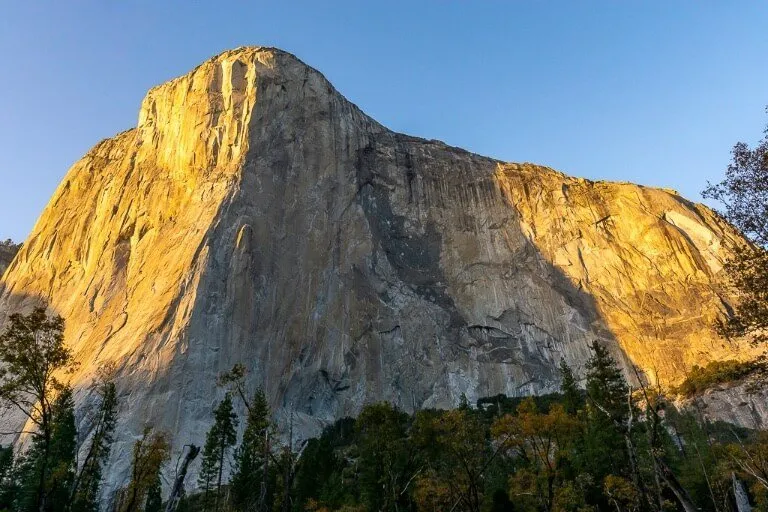
“El Cap” is one of the most impressive and iconic monolithic features in all of Yosemite.
If you hadn’t heard of it a few years back, you certainly have now thanks to nail biting television productions bringing extreme rock climbing to a wider audience.
Watch The Dawn Wall and Free Solo before visiting El Capitan.
When you arrive at the base of El Cap after a short easy hike from a nearby car park, look up and you will really appreciate what these climbers achieved!
Aside from its notoriety, El Capitan is a mightily impressive granite feature in Yosemite. It is best viewed from El Capitan Meadow, Tunnel View and Valley View (more on these later).
Sunrise is the most beautiful time to photograph El Cap as the pink rays of first light illuminate its famous wall.
For those with more time in Yosemite who want to say they’ve walked on the summit of El Cap, you can either climb it or hike a 13.5 strenuous round trip trail beginning close to Yosemite Falls.
Views are not as impressive as at the summit of Half Dome but hey, you’re standing on top of El Cap!
Tioga Pass Road
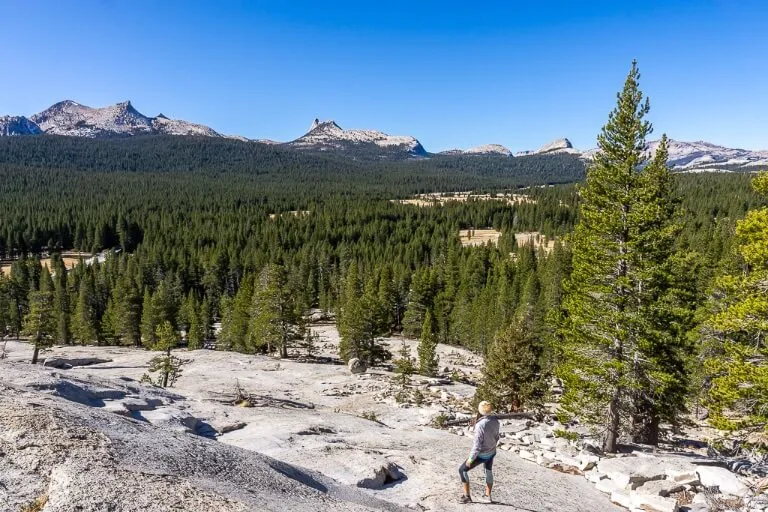
Tioga Pass Road runs from Yosemite’s Northeast entrance (near Mammoth Lakes) to Big Oak Flat Road close to Yosemite Valley entrance.
Use this entrance if also visiting Lake Tahoe, Death Valley or the best natural northern California hot springs around Mammoth Lakes.
This road is also known as CA Highway 120 and is incredibly scenic with plenty of awesome stops along the way.
Although the majority of Yosemite’s highlights are in the valley, Tioga Pass Road – known as the High Sierra – is a fantastic place to begin/end a 3 day itinerary if you have the spare time.
Here are some recommended highlights:
- Hike to Dog Lake and Lembert Dome Summit – 4 mile roundtrip with awesome views.
- Cathedral Lakes hike – 7 mile roundtrip and one of the most popular in the area.
- Olmsted Point – Fantastic viewpoint featuring huge cracked and smooth boulders.
- Others to consider include Tenaya Lake, Gaylor Lakes and Mono Pass (but you can’t do them all!).
Note : Tioga Pass Road is only open May-October. You will not be able to cross the Sierra Nevada on this road between November and April.
Sequoia Tree Groves
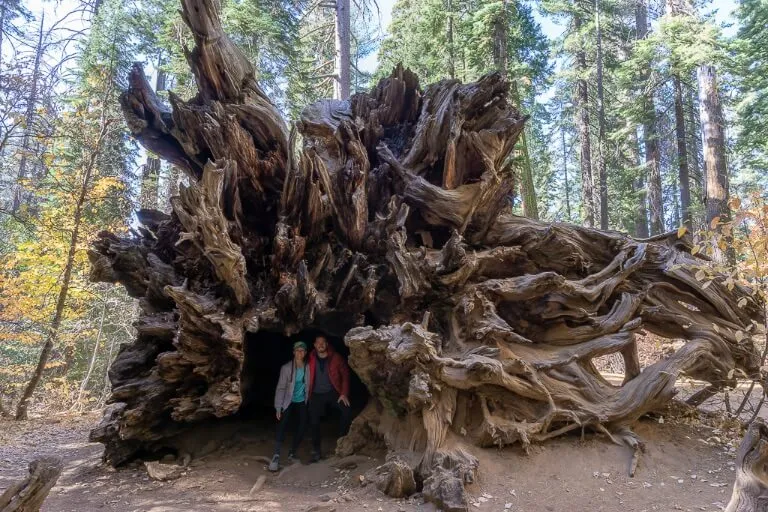
Although not on the scale of Sequoia and Kings Canyon National Park, Yosemite has its own fair share of gigantic Sequoia Trees.
There are three main areas you can walk among Yosemite’s Sequoias:
1. Tuolumne Grove – Located at the joining of Tioga Pass Road and Big Oak Flat Road. A 2.5 mile roundtrip trail with a sharp descent to the grove (and sharp ascent back to the car park) is home to around 30 mature Sequoias.
One dead Sequoia has had a tunnel cut through its base so you can pass underneath and appreciate the circumference of these enormous trees.
2. Mariposa Grove – Located near South entrance. This is the largest and best Sequoia grove in Yosemite with over 500 mature giant Sequoias.
Hike the Big Trees Loop trail if short on time, otherwise, hike the 2 mile Grizzly Giant Loop trail. There are longer trails for those with more days.
3. Merced Grove – The smallest Sequioa grove is located further up Big Oak Flat Road on the way in or out of Yosemite. There are only 20 Giant Sequoias but it is by far the least crowded of the three groves.
You know they’re going to be massive, everything you see and read tells you that, but when you see one in person you will still be shocked!
Glacier Point
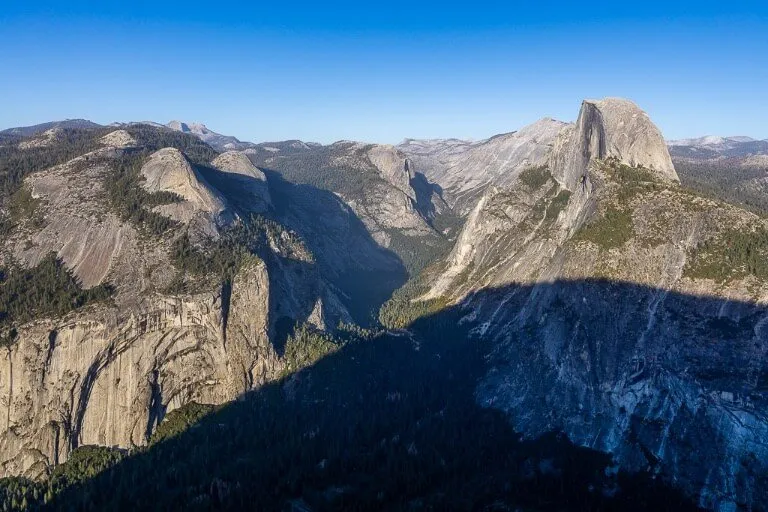
Glacier Point boasts the best panorama in all of Yosemite, arguably on par with Half Dome. However, getting to Glacier Point is not the easiest or most enjoyable.
You have to drive 16 miles up Glacier Point road – a very congested, constantly winding and at times extremely narrow road. That being said, it is without question worth the drama!
Access to this road is 23 miles from South entrance and best driven either at the beginning or end of your Yosemite itinerary.
Magnificent 270 degree views over Half Dome, Yosemite Valley and the Merced River are unbelievable. Glacier Point and nearby Washburn Point are the best places in Yosemite to watch sunset.
There are a number of hikes at nearby trailheads:
- Sentinel Dome – 2.2 mile roundtrip, moderate and find Jeffrey Pine (one of the most photographed trees in the world).
- Taft Point and the Fissures – 2.2 mile roundtrip, easy and stunning views without guardrails found at Glacier Point.
- Four Mile Trail – You can hike to Glacier Point from Yosemite Valley if you take this strenuous 9.6 mile roundtrip trail.
- Panorama – This is an extension of Mist/John Muir trail which can be joined close to Nevada Falls and hiked to Glacier Point, but its 8.5 miles one way and strenuous.
One tip for photographers is to consider the time of your visit because huge valley covering shadows appear in the later afternoon. Astrophotography would be perfect at Glacier Point.
Yosemite Valley
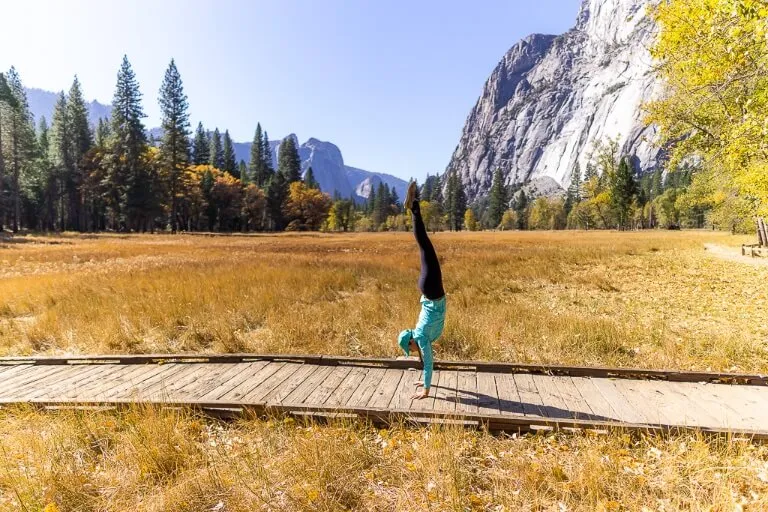
Do not entirely disregard Yosemite Valley in favor of hikes and domes. There are a number of fantastic photography spots around the Merced River, often with reflections of granite monoliths or beautiful autumnal foliage.
Yosemite’s one way loop means you can pull the car over as often as you like. It is perfect for families with older or younger members to enjoy the beauty of this National Park.
Some of the notable stops include Cathedral Beach, Sentinel Beach, Swinging Bridge, Sentinel Bridge, El Capitan Bridge and Valley View (the best one).
You can see the likes of El Capitan and the Three Brothers reflect perfectly on still water in Fall.
Yosemite is one of the top places to visit in the US and you will be blown away by the sheer beauty inside Yosemite Valley. Plan to spend a lot of time here.
Best Yosemite Photography Locations
Yosemite national park is a beautiful part of America, the perfect environment for landscape and nature lovers. Photography doesn’t get much easier than inside the valley, looking up at waterfalls and towering granite domes.
We truly enjoyed taking photographs around Yosemite and will definitely be back in future for many more.
If you would like to see all of our favorites from the park in more detail, read our complete guide to Yosemite Photography next.
Tunnel View
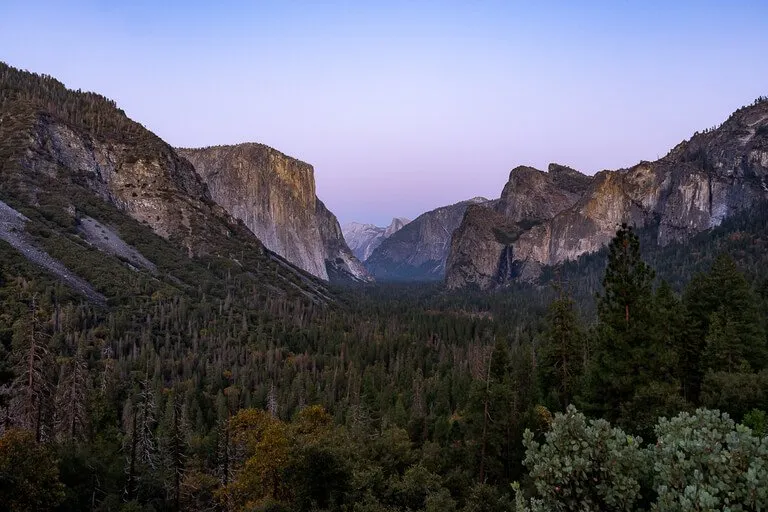
Tunnel View is the quintessential Yosemite photograph made famous by Ansel Adams.
You will see the majestic flat face of El Capitan to the left, straight ahead at the end of the valley is Half Dome on a slight angle and Bridalveil Fall to the right.
Vistas don’t get any better than this wobbly-knees-moment anywhere in the world.
Spring is the best time to capture this iconic image at its most powerful. Bridalveil fall takes the photograph to another level and you won’t get it in Summer or Fall.
Winter is another excellent time to photograph Yosemite Valley from Tunnel View as it is shrouded in mist and a light sprinkling of snow.
There is no hiking involved, you simply park at one of the lots close to Wawona/Yosemite Tunnel just a few minutes drive from the Valley. Arrive at sunrise to avoid the crowd. Sunset will inevitably be busy, particularly in Summer.
Go to Tunnel View instead of driving to Glacier Point for stars, which would be amazing but a lot of effort.
T he Milky Way will appear over the tunnel and you can get a great night shot with the tunnel in your foreground.
Also, if you take a long exposure over Yosemite Valley with a wide angle lens, you will see white streaks on El Capitan – they are rock climbers making a night climb to El Cap’s summit. Pretty cool, right?!
Valley View
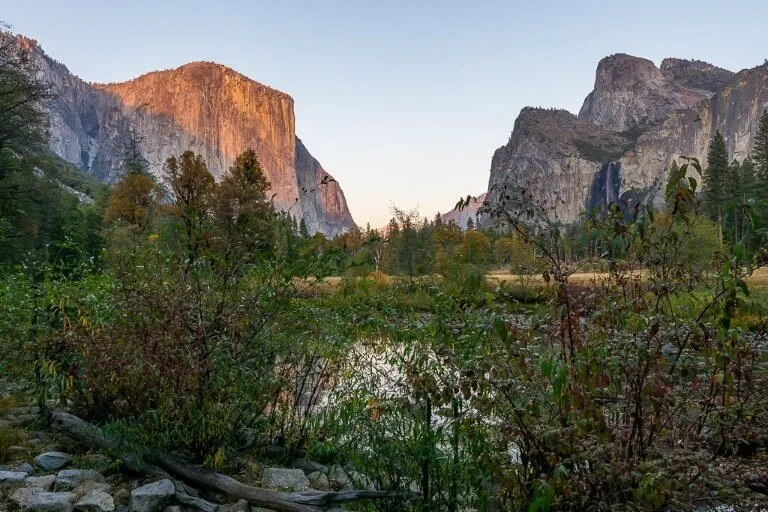
Depending on the type of photography you prefer, Valley View could beat Tunnel View when you consider how much more you can capture in the foreground.
With still water at sunrise, you can compose an image with a reflecting El Capitan glowing red. This place gets busy and there’s not a lot of room to park so plan accordingly, particularly around sunset.
Take a sturdy tripod and wade out into the river – if it is safe to do so – for enhanced composition. Maybe even walk out to a rock and get a photo of yourself in the foreground?!
Various Yosemite Valley / Merced River Rest Areas
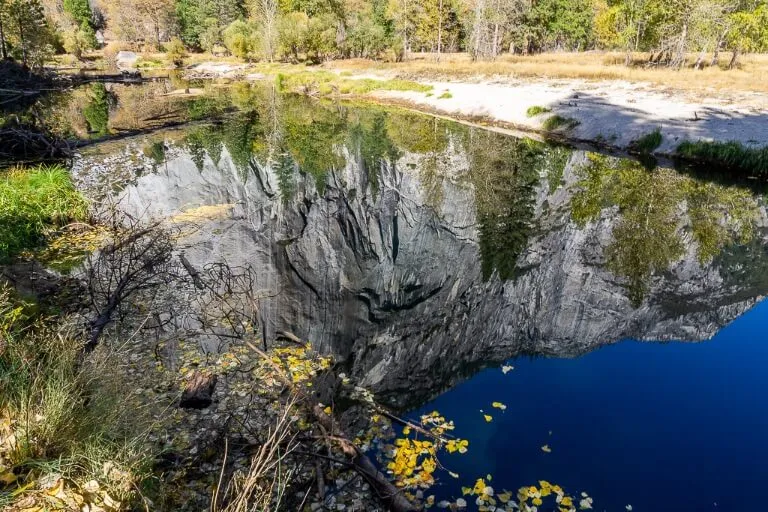
As we mentioned earlier, these Valley floor stop offs aren’t to be missed!
You will see plenty of pro photographers at various points of the day wading through the shallow Merced river (in Fall) searching for the best river reflection shots of towering granite rocks.
Yosemite Valley Meadow
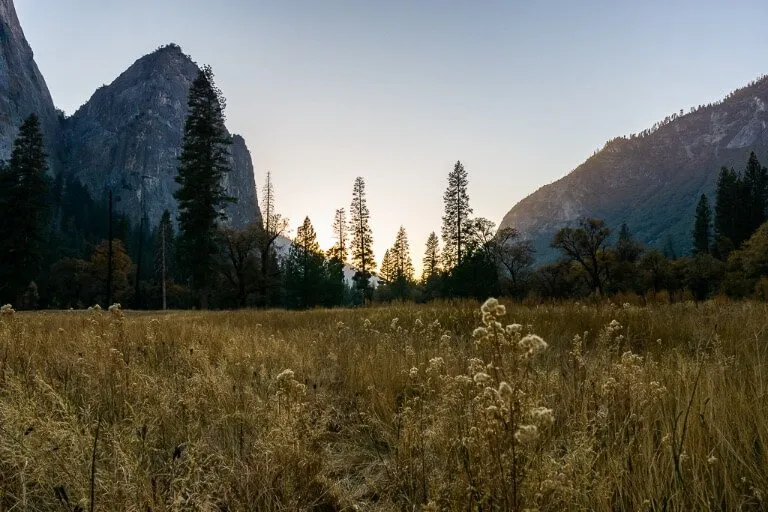
Walk out into the meadows around Yosemite Valley using wooden boardwalks. You will be able to shoot different perspectives of the valley and all of the major features within it.
When we visited in Fall, the meadows had turned yellowy-brown and straw like. Barely anyone will be around and you can get creative with your images.
Yosemite Itinerary Broken Up Into Regions
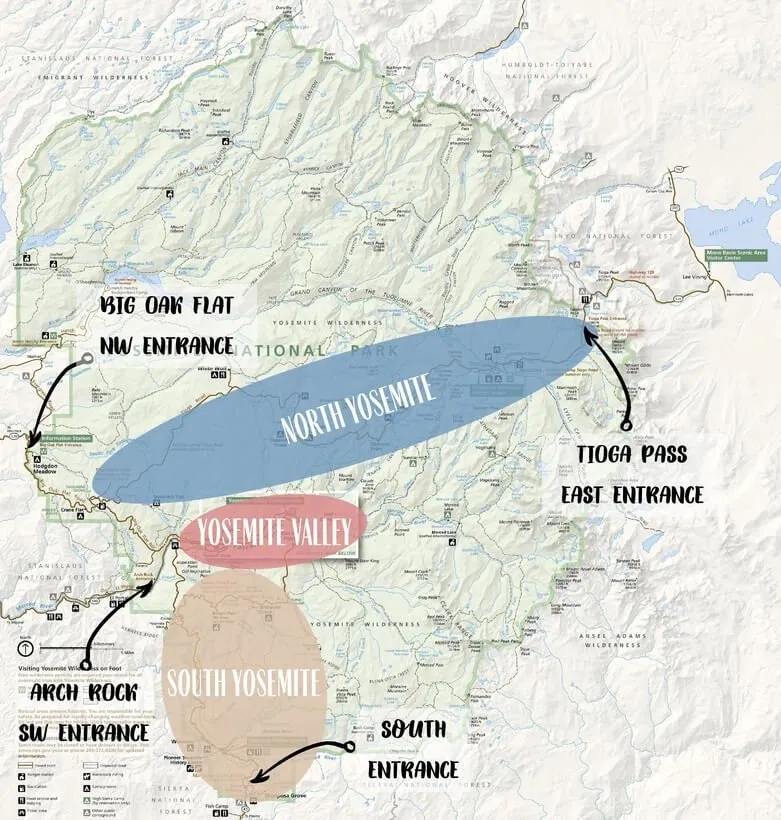
Phew! That’s a lot of information to digest. Yosemite is a big park and it helps to understand the layout.
Above is a map of Yosemite broken into 3 regions: North, Valley and South. You will find each of the 4 entrances labeled to give you an idea of the routes around Yosemite.
Note : This is separate to the Interactive Map at the end of this article on which you can zoom in / out and move around to orientate yourself with Yosemite, accommodation options and itinerary highlights.
How Many Days For The Perfect Yosemite Itinerary?
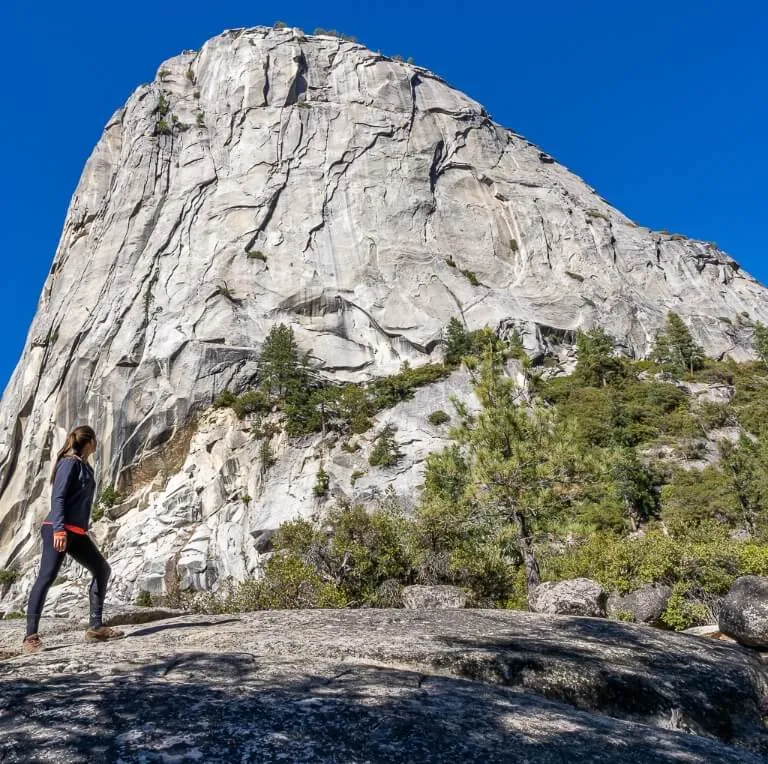
Yosemite is an incredible place, if there’s ever been a true ‘bucket list’ destination, this is it. You could easily spend weeks here and not get bored. However, that is entirely unrealistic for the majority of visitors.
Personally, we believe three days is the perfect amount of time to spend at Yosemite, considering work/life/family commitments and what you can achieve here in 3 days.
However, 2 days will allow you to hit most of the major sights and even in one day you can still get through a big slice of Yosemite pie.
Let’s get stuck into the most efficient way to visit Yosemite for each of those timeframes and make the most of your trip.
Yosemite Itinerary Assumptions
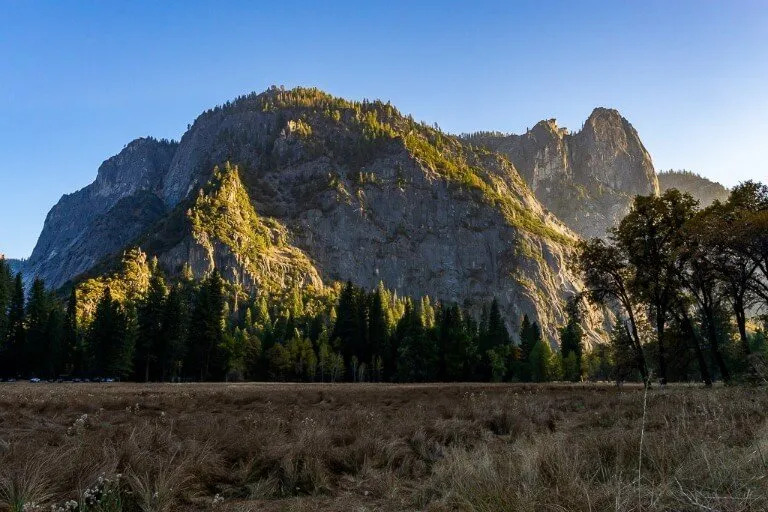
The following itineraries do not include hiking Half Dome. If you are hiking Half Dome it will take one full day but you can pick up the 2 or 3 day itineraries around the big hiking day.
One and Two Day itineraries should begin and end either at Big Flat Oak, Arch Rock or South entrances; a common loop route from San Francisco.
Three day itinerary should begin at East entrance and end at South entrance or vice versa for maximum efficiency, ideally as part of a wider US road trip .
An example route would be Las Vegas – Death Valley – Yosemite – San Francisco .
Yosemite Itinerary Map
We have created a 3 day Yosemite Itinerary map to show you how we would spend 3 days in the park.
Please note the map is based on our 3 day itinerary listed below. Our 1 and 2 day Yosemite itineraries do not feature in this map.
Click into the interactive map, zoom in / out, scroll around and click on any icon to see details of attractions on days 1 -3. Follow the points each day from morning to evening for the most efficient way to see Yosemite.
We always find that spending just a few minutes working out where things are really helps when we arrive.
One Day In Yosemite Itinerary
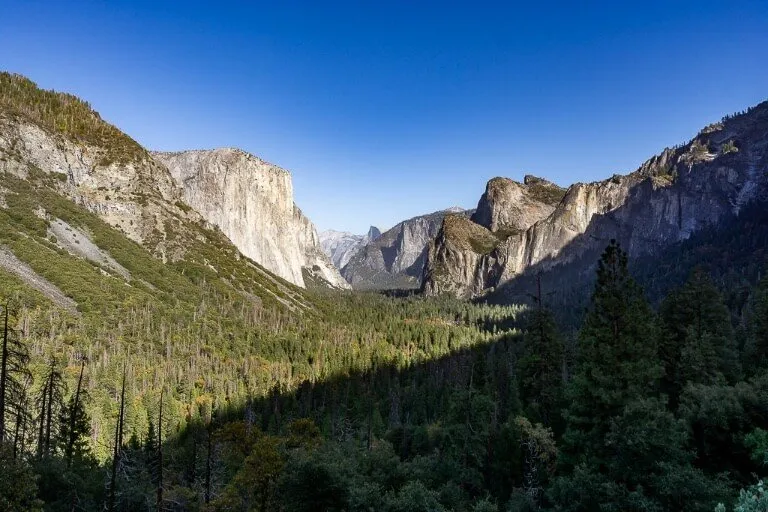
Morning – Day 1
- With just one day available, you will need to arrive early and expect to leave late.
- Drive straight to Yosemite Valley and watch sunrise at Tunnel View .
- Right next to Tunnel View you can park up at Bridalveil Falls trailhead and hike the short trail.
- Drive around the one way loop and take the first left as if leaving the park. Stop at El Capitan meadow/bridge to see the impressive granite tower contrast against the shadowy foreground you are standing in.
- Continue as though you are leaving the valley and stop at Valley View for the other spectacular viewpoint in the park for photography.
- Do not leave the valley, instead drive round in a loop to join back up where you were not long ago. Frustrating to be retracing steps but necessary.
- Drive past the turn you made to El Cap and stop at Cathedral Beach or Sentinel Beach to see reflections of trees and granite towers in the Merced River.
- Continue to the Visitor Center parking lot and park up. Take the shuttle to Mist/John Muir trailhead.
Afternoon – Day 1
- Hike to Vernal Falls and if you’re quicker you can make it up to Nevada Falls . Go down on whichever trail you didn’t go up on to complete the loop.
- Drive to Lower Falls trailhead and walk the short loop to see the tallest waterfall in North America. You won’t have time to hike to Upper Falls.
- On the way out of Yosemite Valley, stop at El Capitan and walk to its base so you can appreciate the sheer scale.
- Drive through Wawona Tunnel and take Glacier Point Road all the way to the end in time for sunset over Half Dome.
2 Days In Yosemite Itinerary
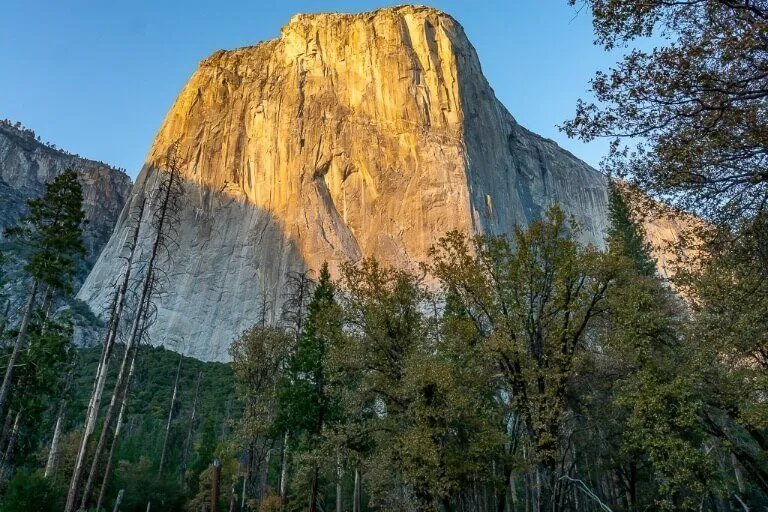
M orning – Day 1
- Enter via Big Flat Oak entrance before stopping at Tuolumne Grove to see Giant Sequoias.
- Drive down into Yosemite Valley, stopping first at Bridalveil Falls, then El Capitan Meadow and Valley View.
- Loop around, stop at every turn off along the valley until you reach either your hotel, lodge or campground. From your hotel or campground, make your way to Mist Trail and hike up to Vernal Falls / Nevada Falls.
A fternoon – Day 1
- Drive the loop, stopping at Cook’s Meadow Loop and Lower Yosemite Falls.
- Walk to the base of El Capitan, stop once more at Valley View and head up to Tunnel View for amazing vistas.
- Head back towards your hotel/campground but stop to watch sunset at either Stoneman Meadow near Curry Village or Sentinal Bridge close to the visitor center. You will have an excellent view of Half Dome at both.
- If you want to stargaze or take astro shots, Summer is best and head to Sentinel Dome / Glacier Point (a long drive) Valley View, Tunnel View or Sentinel Bridge (closer).
M orning – Day 2
- Grab an early start and hike to Upper Yosemite Falls or even further to El Capitan summit. In Spring definitely hike the Falls and only the quicker hikers should continue to El Capitan on the morning of day 2.
- That will take up your entire morning!
- Alternatively, spend the morning walking around the visitor center, Ansel Adams gallery (we bought an awesome astrophotography book here!) and more time in the meadows/valley floor for amazing photography.
A fternoon – Day 2
- Drive through Wawona Tunnel (stopping again at Tunnel View – time of day impacts images) and onto Glacier Point Road. Stop at Taft Point / Sentinel Dome trailhead and choose one of them to hike. Both are great choices.
- Continue to Glacier Point before the huge shadows of late afternoon arrive for the best photographs of Half Dome. It will be busy up here!
- Leave via South entrance but stop at Mariposa Grove to hike the 2 mile Grizzly Giant loop among Giant Sequoia Trees.
Yosemite 3 Day Itinerary
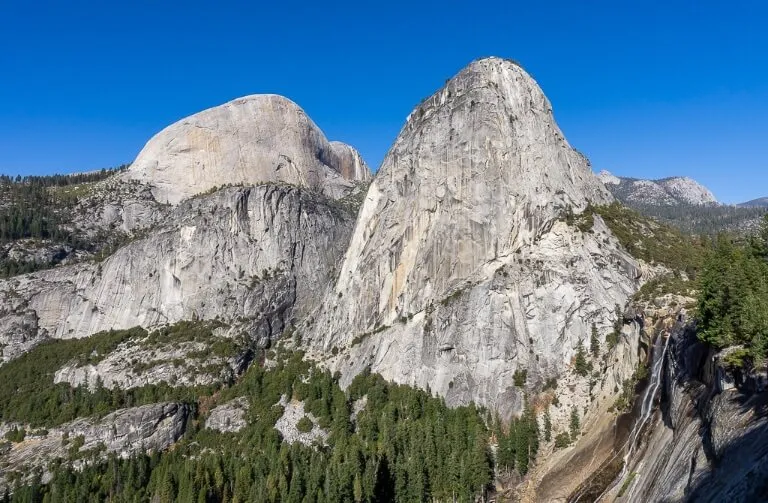
- Enter via South entrance, stop at Mariposa Grove and hike among Giant Sequoias including Grizzly Giant and California Tunnel Tree.
- Head North and take Glacier Point Road all the way to the end. Enjoy sweeping views over Half Dome and the 3,000 feet drop to Yosemite Valley. The views are simply stunning.
- Hike to either Sentinel Dome or Taft Point for more astounding views.
- Drive all the way into Yosemite Valley, stopping at Tunnel View, Bridalveil Fall, El Capitan Meadow/Bridge, Cathedral Beach and Sentinel Beach.
- Check in to your hotel or campground before walking around the Visitor Center and Ansel Adams gallery.
- Sunset at Sentinel Bridge or Stoneman Meadow with great views of Half Dome and stargaze at any of the places mentioned earlier.
- Wake up early to hike up Mist trail before the crowds arrive. Vernal and Nevada Falls, Liberty Cap and the backside of Half Dome await you.
- Return via the John Muir Trail to complete the loop.
- Expect between 4-6 hours of total hiking time.
Afternoon – Day 2
- Walk the Lower Yosemite Falls loop. We saw a mountain lion cub on the loop when we visited. Fortunately we avoided the mother!
- A little further round the loop, hike to the base of El Capitan to see how frightening the prospect of free climbing it would be! More than likely there will be climbers on the wall. Take a telephoto lens or binoculars.
- Spend the remainder of the afternoon around Yosmite Valley’s many meadows, special viewpoints and river reflection spots.
Morning – Day 3
- If you’re a big hiker and don’t mind early starts – wake up and hike to Upper Yosemite Falls as early as possible. Alternatively, hike Four Mile Trail to Glacier Point.
- Both are strenuous and will take a good few hours.
- For those who prefer an easier morning / if you missed Mariposa Grove at the beginning of Day 1 – drive to Mariposa Grove at the start of Tioga Pass Road to walk among Giant Sequoias.
A fternoon – Day 3
- Before lunch both of the above would converge around Mariposa Grove (hikers wouldn’t have time for the Sequoias). Begin the drive up Tioga Pass Road.
- Stop at Olmsted Point for more awesome views including Half Dome and walk around Tuolumne Meadows.
- Choose either Cathedral Lakes trail (7 mile popular roundtrip) or Dog Lake and Lembert Dome(4 mile roundtrip with excellent views from dome summit).
- Leave via East entrance.
Note: This 3 day Yosemite itinerary can easily be done in reverse (East to South entrances)
Yosemite National Park Map of Key Locations and Accommodation
Spend a few minutes studying our interactive itinerary map of Yosemite National Park and its surrounding areas.
Click on the map, zoom in / out and move around to orientate yourself with the park.
- Hotels and Campgrounds in and around the National Park – Purple Markers
- Gas Stations (don’t run out!), Entrances, Visitor Center and Car Parks – Black Markers
- Hiking Trails, Domes, Photography Locations, Major Points of Interest – Orange Markers
Learning the local geography is the best way to save time when you actually arrive into Yosemite.
Where To Stay For Your Yosemite Itinerary
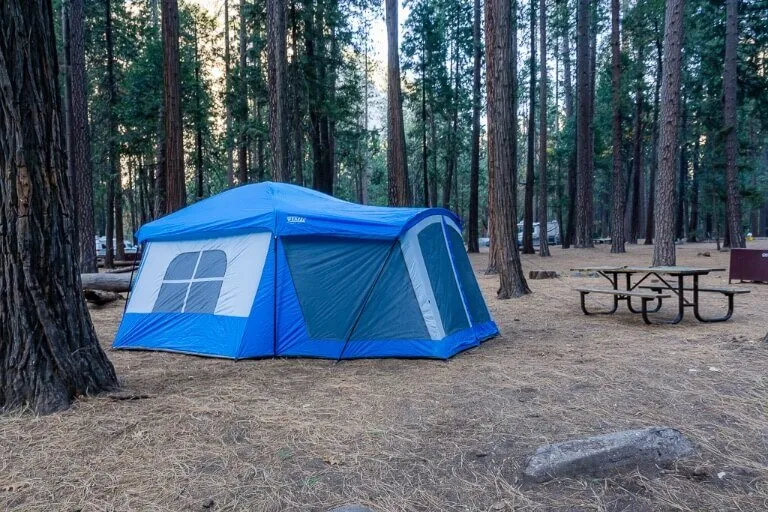
Yosemite’s beauty is revered on a global scale but its popularity means finding somewhere to sleep can be a real problem, particularly in peak season.
We’ve written an extremely popular guide to the best places to stay in Yosemite National Park which we highly recommend as a very useful planning resource.
Campgrounds are notoriously difficult to book and often hotels close to the park charge exorbitant fees.
Whether you prefer camping or hotels, the earlier you know your Yosemite itinerary dates, the better. Be as organized as humanly possible – we’re talking months in advance here!
Our example
We visited Yosemite in October and began to look for accommodation around 1 week before but barely anything was available.
We lucked out with a spot at Upper Pines campground on 1 of our 3 nights but no other spaces at any campground opened up for our other nights.
So, we spent a night in one of the top hotels in Mammoth Lakes the first night and began Day 1 very early entering from East entrance.
Night 2 we spent in a less than perfect yurt-like cabin (yes it was very cold!) between El Portal and Incline, and night 3 was in Upper Pines campground.
From experience, we can tell you how inconvenient driving in and out of the park is each day. But it will be far cheaper.
Another trade off!
Mariposa is a great place to base yourself to save money. We stayed at Best Western Plus Mariposa on night 4 and enjoyed a pizza at Pizza Factory after a few days of camp food!
Book in advance if you don’t want to be traveling long distances or moving every night.
Yosemite Campgrounds
If you know your dates early and are certain you want to camp, book immediately. The same goes for backpackers and Half Dome hikers. The earlier the better in all circumstances at Yosemite!
Here are the 4 campgrounds in Yosemite Valley:
- Upper Pines – Reservations required, available to book 5 months in advance, 238 sites, US$ 26 / night.
- Lower Pines – Reservations required, available to book 5 months in advance, 60 sites, US$ 26 / night.
- North Pines – Reservations required, available to book 5 months in advance, 81 sites, US$ 26 / night.
- Camp 4 – Late May to early September campsites are only available through a daily lottery one day in advance ( information here ). September to May is first-come, first-served but fills early and is only US$ 6 / night.
There are more camping options North and South of Yosemite in Wawona and Tioga Pass road. Check NPS for all Yosemite campground information .
Camping Exclusive
Would you like to camp in Yosemite National Park but can’t find any campsite availability?
We have teamed up with The Dyrt to offer our readers the chance to take advantage of our exclusive 30 day free trial of The Dyrt PRO , which can help you get reservations at sold out campgrounds in Yosemite National Park by using a fantastic new feature called Dyrt Alerts.
You can create alerts to notify you of any cancelations at campgrounds in Yosemite, which is huge. When a space becomes available, you simply book it right away to snag a near impossible campsite in Yosemite.
You can try The Dyrt PRO for free, no strings attached!
Hotels Near Yosemite
Booking hotels in and around Yosemite takes a bit of perseverance and a lot of patience. Usually, we would say being flexible gives you the best chance of grabbing a good deal.
However, unless you book a long way in advance, you might not have a choice to be flexible.
Your first step should be to take a look at hotels and lodges in Yosemite Valley for availability and prices. These hotels and lodges are booked through the National Park Service.
Availability and prices for your selected dates may not work for you. In that case you will need to find a hotel as close to the park as possible .
Your best bet is to find any hotels that have availability for your travel dates. Here’s a complete list of all hotels near Yosemite National Park .
- Input your dates
- Search by list or better yet by map
- Find a hotel (or hotels) in the best regions of the park to suit your itinerary
Cabins / Lodges / Yurts Near Yosemite
A decent compromise between high prices in Yosemite Valley and long drives in/out from the likes of Mariposa is to stay in a yurt, lodge or tent.
There are plenty of these small lodge grounds in places like El Portal, Incline, Yosemite West, Wawona and Fish Camp.
More From Yosemite
- Yosemite Mist Trail: Fun Hike to Vernal and Nevada Falls (John Muir Loop)
- Where To Stay At Yosemite: Best Places, Hotels and Lodging Options
- Yosemite In October: 10 Important Things To Know Before You Go
- Yosemite Photography: Best Locations, Iconic Landmarks and Epic Vistas
More From California
- Pacific Coast Highway Road Trip: 23 Stops San Francisco to San Diego
- San Diego Itinerary: 9 Unmissable Things To Do In 3 Perfect Days
- San Francisco Itinerary: 15 Amazing Things To Do In 3 Awesome Days
- 10 Unmissable Things To Do In Los Angeles For First Time Visitors
- Alcatraz Tour Review: Is It Worth Your Valuable Time And Money?
- One Day In Death Valley: Perfect Day Trip Itinerary From Las Vegas
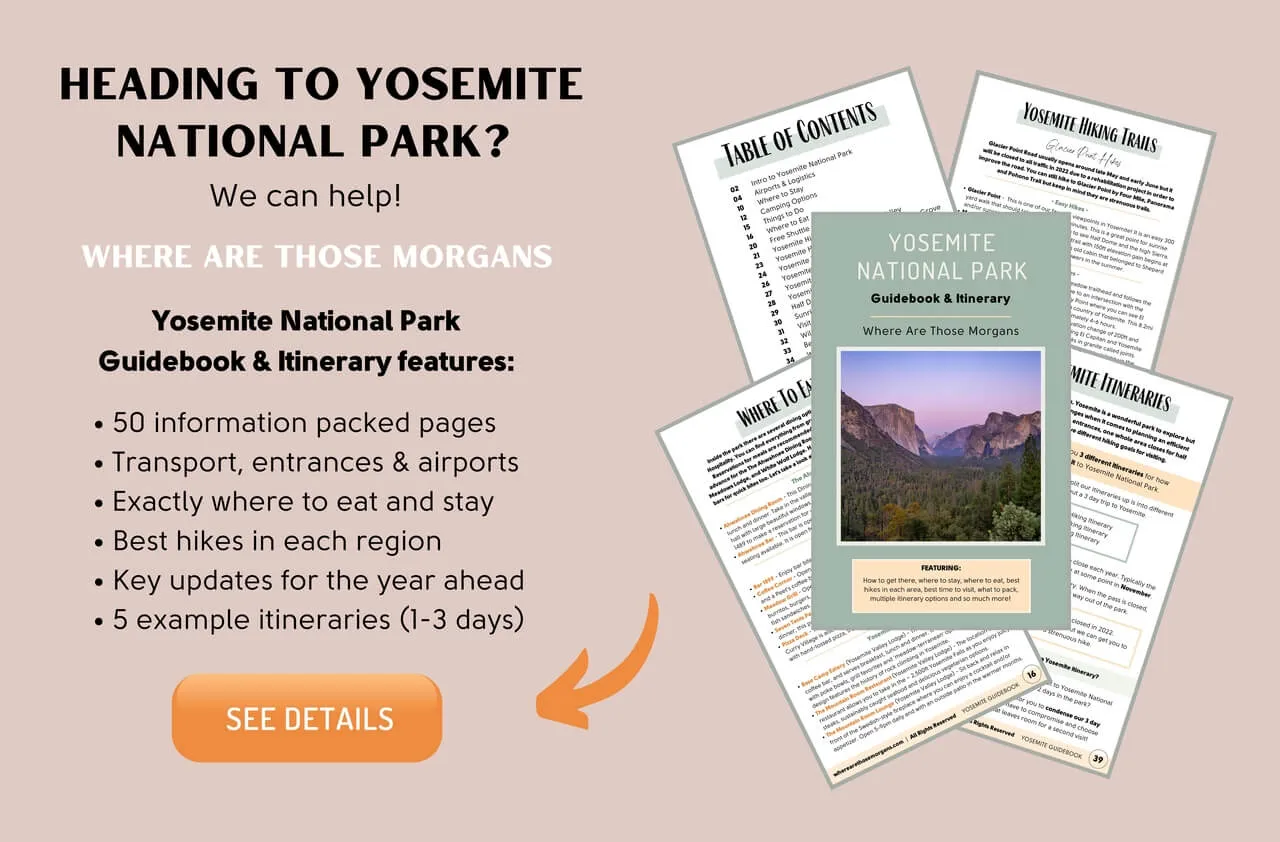
We hope this helped you plan your Yosemite National Park itinerary!
Have you been to Yosemite? What was your favorite part?
Please let us know if you have any questions or need any help planning your visit to Yosemite in the comments below.
Happy Travels ,
Mark and Kristen
Was This Post Helpful? Pin It For Your Visit to Yosemite!
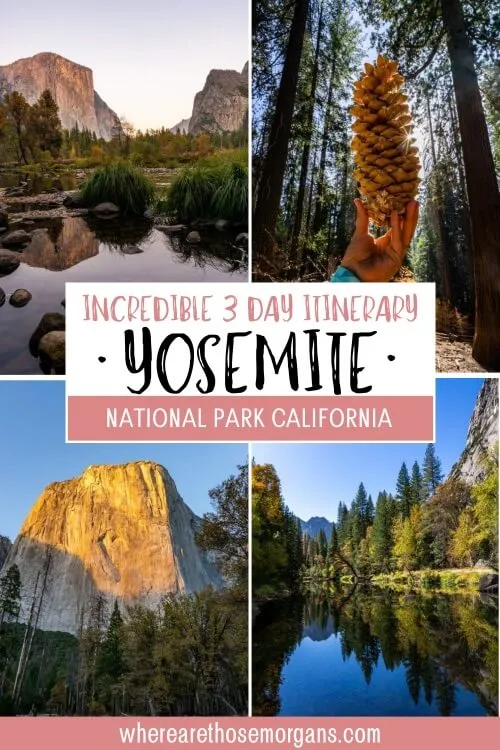
Note : This article contains affiliate links. When you make a purchase using one of these affiliate links, we may earn a small commission at no extra cost to you.
All Rights Reserved © Where Are Those Morgans, LLC. Republishing this article and/or any of its contents (text, photography, maps, graphics, etc.) in whole or in part is strictly prohibited.
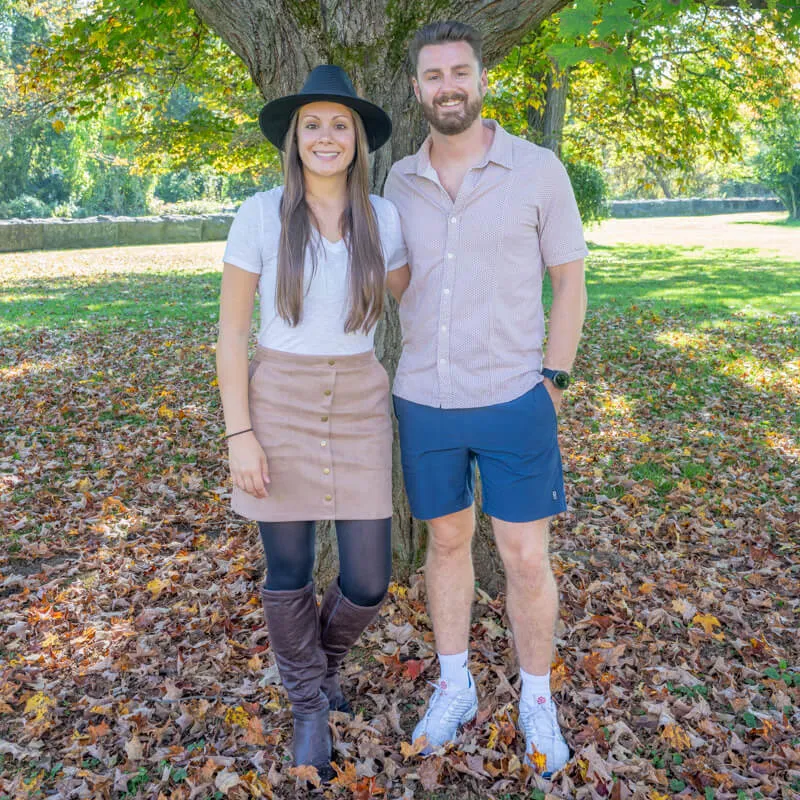
Mark and Kristen Morgan are travel, hiking and photography experts. Over the last 6 years traveling full time, they have explored more than 40 countries and 30 US states.
Where Are Those Morgans has been featured in USA Today, Gestalten, Get Your Guide, CityPASS and Condé Nast Traveler along with various other publications. Read more about us .
12 thoughts on “Yosemite Itinerary: Ultimate First Time Visitor Guide (1, 2 & 3 Day Itinerary)”
Hello Mark, I want to come from San francisco to yesemite for 2 days and then go to lake taho via tioga pass from October 17th to 18 ( at yosemite) and leave either on 19th or 20th to lake taho. I just need little help to let me know how to exit the park for tioga pass to Lake taho. I have seen your maps but i just needed littel help. YOU have done such a wonderful job of visiting yosemite in october…thank you Mark
Hi Anjana, we’re glad to hear you will be visiting Yosemite in October, the valley is beautiful and a little less crowded this time of year. You should be fine leaving Yosemite via Tioga Pass Road on October 20th (the earliest they have closed that road in the last 10 years is October 21 but it is usually November). You will exit Yosemite Valley on Big Oak Flat Road and take a right turn onto Tioga Road near Tuolumne Grove. That road will take you all the way out of the park to the northeast. Once you reach Lee Vining, take a left onto US-395 N heading for South Lake Tahoe. Have a great time!
Any chance you have a similar guide for Kings Canyon/Sequoia and Joshua Tree?
Hi Kyle, Unfortunately we do not, but we hope to have more Guidebooks published later this year. In the meantime, feel free to reach out with any questions 🙂
Great article!!
We are coming in from Monterey and staying 1 night in Mariposa… Which entrance and itinerary would be best suited to us please!
Thanks, Vish! If you are coming in from Monterey, the best entrance to use is Arch Rock entrance on El Portal Road. Assuming you have 2 days including travel both ways we would suggest spending the first day exploring all of Yosemite Valley after arriving, staying in Mariposa, heading back into Yosemite via Oakhurst and Fish Camp so you can do the Mariposa Grove of Sequoias and Glacier Point, before maybe hiking another trail in Yosemite Valley. We would then leave via El Portal Road to head back to Monterey. It is a lot to drive in just 2 days and staying in Mariposa means you have to drive back out and in again then next morning, but you will still be able to see the top sights easily, especially if you don’t take on any of the longer hikes. Let us know if you have any more questions and have a great trip!
Thank you so much!! This really helps to plan our 3 day trip to Yosemite! Great information and details!
Hi Shrenik, we’re very happy to help and hope you have a fantastic trip to Yosemite!
Enjoyed this so much! My granddaughter is a ranger at Wawona. Her mom and I are hoping to travel to Yosemite this summer. Thank you for all your travel tips!
Thank you Sylvia, Yosemite is a beautiful park – your granddaughter has a great job! We really hope you are able to make it this Summer and enjoy your trip!
An amazing national picture perfect park, almost everything you could wish to see in one place. Excellent pictures once again, keep it up.
Thanks Graham! Yosemite really is difficult to beat for landscapes and photography. Hope you get to use this Yosemite itinerary one day!
Leave a Comment Cancel reply
Subscribe to our newsletter
Get the latest in travel straight to your inbox
Click here to subscribe
Yosemite National Park Vacation Guide
:max_bytes(150000):strip_icc():format(webp)/betsy-hikey-1000x1500-56a386bf3df78cf7727ddc41.jpg)
TripSavvy / Jess Macdonald
If you're planning a Yosemite vacation, these resources will help you plan your trip like a pro.
Yosemite National Park is in the Sierra Nevada Mountains, on the east side of California. Almost due east of San Francisco , it's a four-hour drive from there and about six hours' drive from Los Angeles. All the ways to get there, from San Francisco, are summarized in this guide: how to get to Yosemite .
What to Expect at Yosemite
Yosemite's heart is a glacier-carved valley. Soaring granite monoliths, cliffs, and waterfalls surround you—and a river runs through the middle of it all. Mile for mile, it offers some of the most spectacular scenery you're likely to see anywhere. Elsewhere in the park, you'll find groves of giant sequoia trees, high mountain meadows, and panoramic views of the mountains and valleys.
Visitors go to Yosemite National Park for the natural beauty and outdoor recreation. You don't have to be a hyper-fit backpacker to enjoy it. There are plenty of things to see on short, easy hikes or even from the windows of your automobile. Families also enjoy taking the kids there.
How Long to Stay on Your Vacation
You can get a nice look around in just one day. To make the most of such a short visit, use this guide to one day in Yosemite . If you can stay for a weekend, try the Yosemite weekend getaway planner .
If you only plan to do a few hikes and drive around to see the sights, three days is enough to see most everything. If you'd like to linger, you'll have time to enjoy more ranger-led activities, attend evening programs, take tours, and hang around enjoying the scenery.
Key Locations in Yosemite National Park
The best way to get a sense of where things are located is to take a look at the Yosemite map . It shows all the lodging in the park, entrance stations, and major sights, but here's a summary:
- Yosemite Valley : Sights to include are El Capitan, Half Dome, Bridalveil Falls, Yosemite Falls, and the visitor center. You'll find a variety of hotels here, plus a campground and tent cabins.
- Glacier Point : A viewpoint just above the Valley, giving a different perspective on its sights—along with sweeping views across the surrounding mountains and a great view of Half Dome.
- Wawona and the Mariposa Grove : Located here is the classic hotel Wawona Lodge , and the biggest and most easily accessible grove of giant sequoia trees is nearby.
- Tuolumne Meadows and Tioga Road : Drive east through the park on CA Highway 120, which takes you through a high mountain meadow and the Tioga Pass. You'll get some excellent views along the way at Olmstead Point and Tenaya Lake.
- Hetch Hetchy : Accessed by a separate entrance from the rest of the park, Hetch Hetchy's main feature is a lake, created as a water supply for the city of San Francisco.
How to Support Yosemite and Save Money
The non-profit group Yosemite Conservancy restores trails and lookouts and protects habitat and wildlife. Get a membership before you go, and you'll not only support their work, but you'll also get a bunch of discount coupons that will save you money on lodging, food, and activities. Visit their website to find out more.
Yosemite National Park: The Complete Guide
Scenic California Drives: 7 Routes That Will Make You Swoon
How to Be a Smart Yosemite California Trip Planner
Tips for Avoiding the Summer Crowds at National Parks
Tuolumne Meadows: A Trip Worth Taking in Yosemite
Yosemite Valley Guide
Fall in Yosemite: Weather, What to Pack, and What to See
5 Easy Hikes in Yosemite Valley
The Best National Parks Near Las Vegas
RV Camping at Yosemite: What You Need to Know
Summer in California: Weather, What to Pack, and What to See
Yosemite Trip Planner: Weekend Getaway Guide
How to Travel From San Francisco to Yosemite by Train, Bus, Car, and Plane
Yosemite Lodging: A Complete Guide
Best of the West: Top Tourist Destinations
December in California: Weather, What to Pack, and What to See
8 best things to do in Yosemite National Park

Mar 19, 2024 • 8 min read
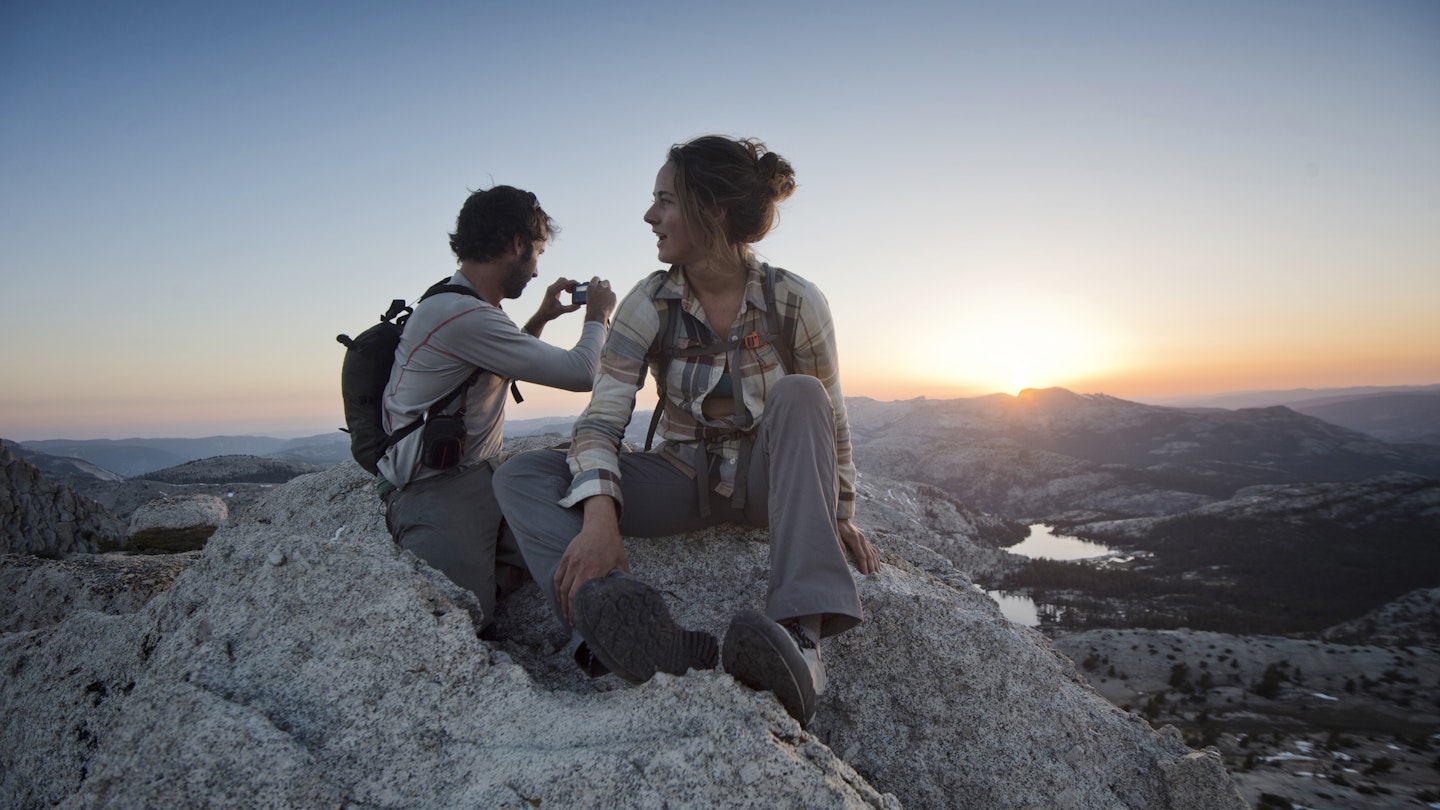
Yosemite is a wonderland of adventures – here are our favorites © R. Tyler Gross / Getty Images
Yosemite National Park is one of those dazzling, large-than-life destinations with a beauty that must be seen firsthand to truly appreciate it.
Renowned landscape photographer and environmentalist Ansel Adams introduced much of the public to this iconic park in the 1930s, when he began documenting its magic in black and white. Close to 100 years later, Yosemite remains an iconic photographic locale attracting close to five million visitors each year.
In California’s Sierra Mountains, Yosemite is the third-oldest national park in the US, established in 1890 and home to more than 700 miles of hiking trails, numerous waterfalls and captivating granite cliffs and buttresses with names like Half Dome and El Capitan. You’ll also find towering sequoia trees, diverse wildlife, sparkling turquoise and aquamarine lakes, scenic byways and a historic lodge that takes you back about a century in time.
Here are our top picks for the best things to do in Yosemite National Park.
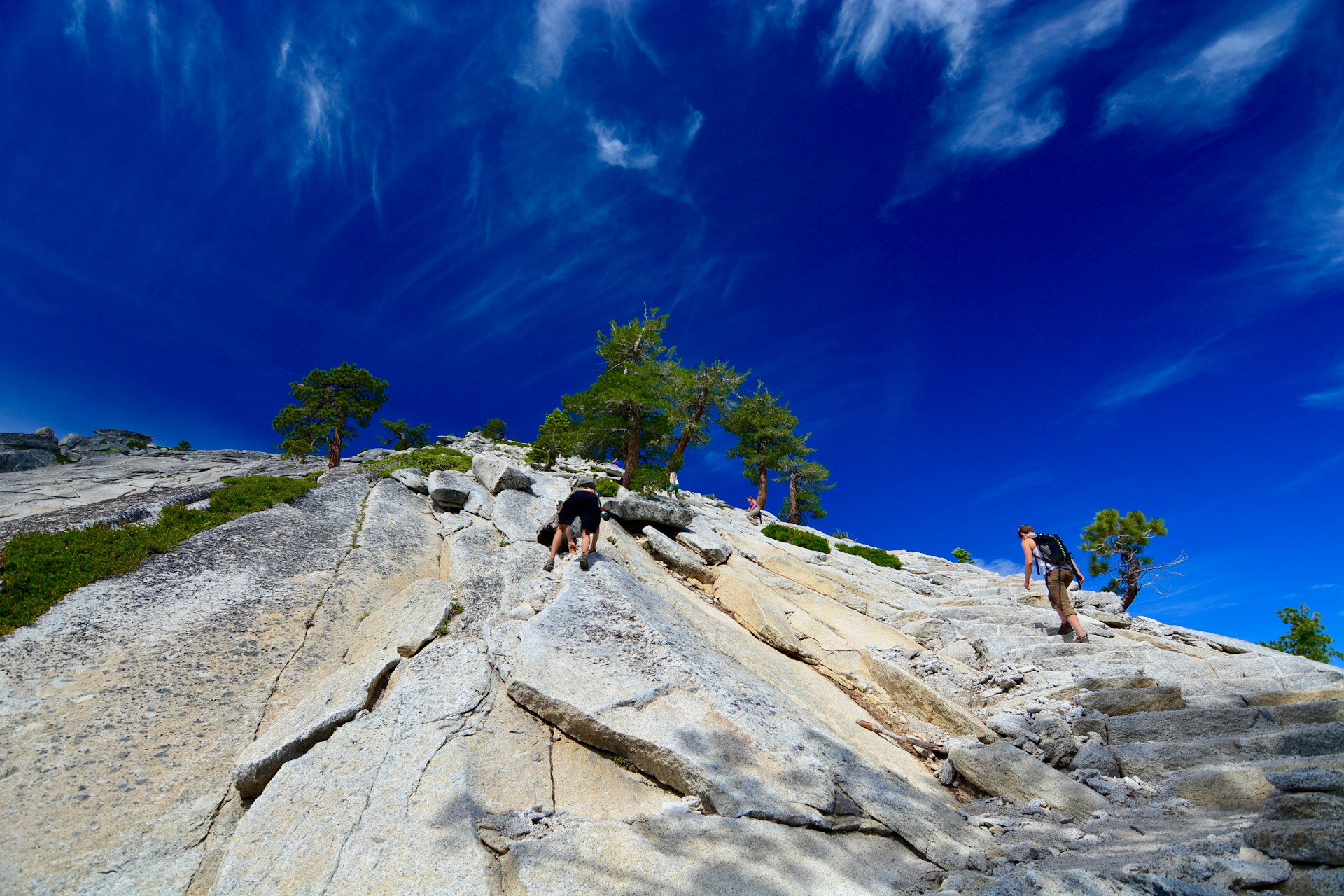
1. Summit the iconic Half Dome
If you’ve seen photos or videos of Yosemite, you’ve seen the iconic granite rock that is Half Dome . Towering nearly 5000ft above the Yosemite Valley, it can be spotted from several locations around the park, including Tunnel View, Glacier Point and Mirror Lake, but none is more exhilarating than the view from the summit.
This is not a hike to undertake if you are not active or prepared. A 14- to 16-mile round trip with a 4800ft elevation gain, the trek to the summit is no walk in the park. It takes most hikers between 10 to 12 hours to hike up Half Dome and return.
All that said, if you're looking for a challenge, this is a stupendous hike that offers stunning views of Vernal and Nevada Falls and Liberty Cap. From the shoulder and the summit of Half Dome, you’ll also have panoramic views across the Yosemite Valley and the High Sierra Mountains.
You’ll want to start this hike before sunrise and, although the trail is marked, carry a good topographic map and compass. Unless you are a rock climber with equipment, you’ll also have to use a two-cable system to climb the last 400ft to the summit.
If the cables are too much (or you can’t get a permit) you can still climb as far as Sub Dome, which is where the cable section starts. The views from here are still really impressive, and the hike is intense.
Planning tip: You can only summit Half Dome between Memorial Day and Indigenous Peoples Day, and you'll need a permit to hike past the Sub Dome area. Apply online in March for one of the 225 hiking permits offered each day of the season. The NPS issues them via a lottery system, and competition is stiff.

2. Experience the magic of El Capitan
Yosemite’s other legendary slab of rock is El Capitan , which garnered a lot of attention after Alex Hannold’s free solo climb in June 2017. The subsequent Academy Award–winning Free Solo documentary told the story of Hannold becoming the first person to summit El Capitan using only his hands, no ropes.
Today, this nearly 3600ft sheer cliff remains a hotspot for climbers. On Yosemite Valley’s north side, it can be seen from numerous points of interest around the park, like the Tunnel View lookout and El Capitan Meadow. The latter is the best spot to photograph this massive rock (it is 1000ft taller than Half Dome’s face). You’ll find the meadow on the North Drive through the Yosemite Valley.
Planning tip: Bring a pair of binoculars so you can spot the climbers from a distance.
3. See the Yosemite Valley from Tunnel View Lookout
The Yosemite Valley is where many of the park’s top attractions are located, including Tunnel View lookout. The parking lot is located right off Hwy 41, just east of Wawona Tunnel as you enter the Yosemite Valley, and it offers spectacular views of the Yosemite Valley. You’ll be able to see El Capitan to your left, Bridalveil Falls to your right and Half Dome in the distance. In the foreground is a sea of green trees and more granite cliffs.
Try to visit just before or at sunset, when the granite monoliths glow golden from the setting sun; the green of the trees is especially vibrant. Crowds can be serious, however, in summer. If you are visiting in winter, you might have the place nearly to yourself, and the granite walls look especially magical when blanketed in snow. Come in May to see Bridalveil Falls at peak flow.

4. Drive Tioga Road
Running east-west across Yosemite, Tioga Rd is only open in the summer. Opening and closing dates vary based on when the road can be cleared in spring and when it first begins to snow in fall. Beginning at Tioga Pass, at the park’s east entrance, with an elevation just shy of 9945ft, Hwy 120 is a wonderfully scenic 46-mile drive , and traversing it to Crane Flat in the west is well worth the park fee alone.
The drive takes you past Tuolumne Meadows, wide-open subalpine terrain bisected by the curvaceous Tuolumne River. You’ll also pass wildflower-strewn fields, deep-green forests, granite domes and hiking trails that lead to clear-blue mountain lakes, into which craggy granite peaks are reflected in the right light.
5. Photograph Yosemite Falls in spring
One of Yosemite’s most memorable sites is Yosemite Falls , and what makes it so alluring is that it only exists for part of the year. Spring is the best time to see the falls – the water is at its mightiest and most photogenic between April and June, thanks to melting snow. By August, however, the waterfall is usually down to a trickle or completely dry. Late fall storms can bring more water to Yosemite Falls, and in winter you may see an ice cone at the base of the upper falls.
One of the tallest waterfalls in the world, Yosemite Falls is made up of three waterfalls. Upper Yosemite Fall drops 1430ft down a granite wall, then the middle cascades drop 675ft before Lower Yosemite Fall drops off another ledge for 350ft.
Planning tip: There are lots of spots to photograph Yosemite Falls in spring. If you want to walk, you can take a 1-mile loop trail to the base of Lower Yosemite Falls. This is also the start of the Yosemite Falls hike, which is a strenuous day hike of close to 8 miles. But walking to the base of the falls is easy and still gives a great perspective.

6. Stroll to Glacier Point lookout
Open only from late May through October, Glacier Point Rd is one of the park’s most famous drives. It takes you to Glacier Point , one of the most impressive views in the entire park, looking out over Yosemite Valley, Half Dome, Yosemite Falls and the park’s high country.
The lookout itself, which is 3214ft above Curry Village, is accessed from the Glacier Point parking lot via a short, wheelchair-accessible paved trail. During the months when the road is open, you can also visit the lookout on the Glacier Point bus tour.
Detour: After checking out the viewpoint, take the Four Mile Trail down to Yosemite Valley, some 3200ft below. A little less than 5 miles long (the name is confusing), the trail is steep with some good views and drops you out near Sentinel Rock. You can also hike it up to Glacier Point. Either way, check the bus schedule to see if you can catch a ride back the other direction.
7. Hike to Columbia Rock and beyond
Yosemite National Park is a hiker’s paradise , with more than 750 miles of trails to explore. One of the top moderate hikes in the park is up to Columbia Rock, from which you have 180-degree views of Yosemite Valley, including Half Dome to the east and Cathedral Spires to the west.
The 3-mile roundtrip hike begins at the Lower Yosemite Falls trailhead and gains about 1000ft in elevation as it continues onto the Upper Yosemite Falls trail, making it a relatively demanding hike complete with switchbacks. The trip takes between two and three hours, depending on how fast you walk.
Columbia Rock is also part of the trail system that initially takes you to the top of Yosemite Falls, located another two-thirds of the way on the Upper Yosemite Falls trail. You won’t be able to see the falls from the lookout, but continue for another half-mile and you’ll get great views of them. You can also continue to the top, which is a 7.6-mile round trip.
8. Bike to Mirror Lake
If you are looking for an easy, family-friendly bike ride that also offers awesome, just-in-front-of-you views of Half Dome, consider the Mirror Lake trail. The paved service road runs along the north side of the river and is part of Yosemite National Park’s 12 miles of paved bike paths.
Bike rentals are available at Curry Village. From here it is an easy .8-mile ride via Happy Isle Loop Rd to the Mirror Lake Trailhead. The path can also be walked, so keep an eye out for pedestrians. Note that to reach the upper section of the lake itself, which is known for its Half Dome reflections, you’ll need to walk the final, short portion of the trail.
This article was first published Feb 17, 2023 and updated Mar 19, 2024.
Explore related stories

Jun 1, 2024 • 6 min read
Not many parts of LA's coastline are as iconic, colorful or strange as Venice Beach. Find out for yourself on this self-guided walking tour.

May 24, 2024 • 6 min read

May 15, 2024 • 5 min read
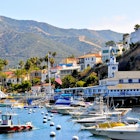
May 7, 2024 • 7 min read
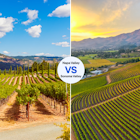
Apr 29, 2024 • 7 min read
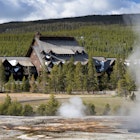
Apr 22, 2024 • 13 min read
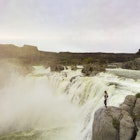
Apr 18, 2024 • 7 min read

Apr 14, 2024 • 8 min read
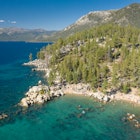
Apr 13, 2024 • 6 min read
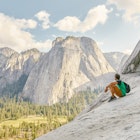
Mar 24, 2024 • 7 min read
- Search Please fill out this field.
- Manage Your Subscription
- Give a Gift Subscription
- Newsletters
- Sweepstakes
- National Parks
How to Plan the Perfect Trip to Yosemite National Park, According to Naturalists and Park Experts
Here’s everything you need to know before planning a trip to Yosemite National Park.
- Planning Your Visit
How to Get There
- Best Time to Visit
Best Things to Do
Wildlife and natural features, places to stay, places to eat.
Irjaliina Paavonpera/Travel + Leisure
Known around the globe for its majestic granite monoliths and overwhelming beauty, Yosemite National Park earned its status as a UNESCO World Heritage Site back in 1984. Yosemite boasts five of the planet's tallest waterfalls, pristine streams, three sequoia groves, picturesque meadows, and rich biological diversity. As one of the first national parks, Yosemite helped pave the way for the National Park System, and over its sprawling 1,200 square miles — equivalent to the size of Rhode Island — the park offers abundant activities and experiences.
“There are over 1,500 different species of plants in Yosemite. That's something many people don't think about when they come to Yosemite because the geography gets all the glory. The towering cliffs and Half Dome and El Capitan, and these giant waterfalls that tumble off them,” Cory Goehring, lead naturalist at the Yosemite Conservancy, said in an interview with Travel + Leisure . “But what excites me as a naturalist, and I think what other people should pay more attention to in the park, is the diversity of life.”
To enjoy all Yosemite has to offer, here are important things you should know, including logistics, trails, and places to stay, informed by three experts who intimately understand Yosemite in different ways — and love it all the same.
Meet the Experts
Cory Goehring is the senior naturalist for the Yosemite Conservancy and has lived in and loved the park for 17 years.
Mike Augustine is a T+L A-list advisor and U.S. national parks specialist.
Mikah Meyer visited 419 U.S. National Park Service sites on a three-year road trip, becoming the first person to accomplish this on a single journey.
Planning Your Visit
Valerie de Leon/Travel + Leisure
A standard entrance pass costs $20-35, depending on whether you enter on foot, motorcycle, or in a private vehicle with fewer than 15 passengers. The pass covers everyone inside the vehicle and is valid for seven consecutive days. An annual entrance pass that costs $70 grants access to Yosemite for 12 months. The park is open year-round, though certain roads, like Tioga Road and Glacier Point Road, close for the winter season due to snow.
Driving into or through Yosemite requires a reservation from April 13 through Oct. 27, with a few exceptions:
- From April 13 through June 30, you need a reservation only on weekends and holidays.
- From July 1 through Aug. 16, you need a reservation every day of the week.
- From Aug. 17 through Oct. 27, you need a reservation only on weekends and holidays.
Reservations cost $2 each — a small price for the significant benefit of limiting vehicle congestion, but securing one can be tricky during peak months.
“They're sort of like buying concert tickets with how popular that park is. You have to be on your game to get up during these times,” said Augustine. “They release a big batch of them early in the year, and then every day around 8 a.m., the national park releases more, so if you get on early enough in the day, you can get a permit for the peak hours.”
Find tickets on recreation.gov .
Mark Miller Photos/Getty Images
Yosemite has five main entrances:
- Hetch Hetchy Entrance: Access this seasonal entrance via Highway 120, which traverses the park.
- Big Oak Flat Entrance: This is off Highway 120 and an easy entry point if you’re coming from the Bay Area.
- Arch Rock Entrance: If you're coming in the wintertime, opt for this all-year entrance off Highway 140. “That is the lowest elevation entrance into the park,” Goehring said. At higher elevations, you’re more apt to encounter tricky winter conditions.
- South Entrance: This entry point works best if you're driving from San Diego or Los Angeles.
- Tioga Pass Entrance: This eastern entrance is accessible via Highway 120 and is open May through October. “That is probably my favorite entrance because I'm a bit biased towards the higher elevations of the park,” said Goehring.
If you’re flying, “Fresno, San Francisco, or Oakland are probably the best places to arrive,” Augustine said. Once you park in Yosemite Valley, you can take the free shuttle throughout the day and avoid driving around the park.
You can also take public transportation, which many people don’t realize.
“If you take public transportation into the park, you do not need to have a reservation,” Goehring said. Yosemite Area Regional Transport System , or YARTS, runs year-round on Highway 140 from Merced, California, in the Central Valley, into the park. It also has seasonal routes. You can stay at one of the gateway communities (like Merced, Mariposa, Midpines, and El Portal) and hop on at one of the many YARTS stops. YARTS also connects with Amtrak and Greyhound .
“[YARTS] is a great way to come into the park because one of the frustrations people have is that it can be hard to find a parking spot when there's no permit,” Goehring said. Additionally, “You get to look out the window the entire way, and you don't have to worry about driving the winding roads.”
Best Time to Visit
Irjaliina Paavonpera/Travel + Leisure
What’s the best time to visit Yosemite ? Goehring gets this question a lot and has an unexpected answer: “I think what people are looking for whenever they ask this question is a time when the weather is quote-unquote 'good.' But I think Yosemite has the best character whenever it's about to snow or rain. People think, ‘Oh, that's when the weather is bad,’ but that's when Yosemite is so amazing,” he said. “The pictures that I put on my desktop backgrounds or on my phone are not the beautiful sunny days of Yosemite; it's the days that are kind of gray and the clouds are moving across the cliffs.”
Winter and early spring are some of Goehring’s favorite times to visit the park, and indeed, a surprise snowstorm can create spectacular scenes. If you visit Yosemite during the winter , be sure to monitor weather conditions, which can be unpredictable, and come prepared with chains on your tires. That said, those moody days deliver.
“The day after a heavy rainstorm, you come out in the morning, and the fog is lifting out of the valley. The clouds are grazing the face of Half Dome; those are amazing,” Goehring said. “It takes a little more planning, but those are some of the most magical times in Yosemite.”
He also acknowledges that nothing beats the middle of July when it's 115 degrees in the Central Valley of California, but at 10,000 feet in the Tuolumne Meadows, it’s 75 degrees and sunny and the flowers are blooming.
Ultimately, the best time to visit depends on what you’re after. Augustine recommends spring if you’re chasing waterfalls and wildflowers, though high passes and viewpoints might be closed if there’s still snow. “The waterfalls tend to be much fuller during the spring as the snow melts in the higher elevations, so you get beautiful waterfalls,” he said. For the best hiking, he recommends June to August, especially if you want to go to high alpine areas. Just note there will be greater crowds. They'll thin in the fall, and September is just as spectacular as July and August.
Meyers agrees but adds that the earlier in the summer you go, the less likely you are to encounter wildfire complications. “I hate to say that because August and September could be beautiful, but if this is like a once-in-a-lifetime trip, and you're getting your whole family together, you want to mitigate your risk of wildfires closing the park,” he said.

Explore Yosemite Valley.
"[Yosemite Valley’s] a must-see destination," Goehring said, highlighting this popular section of the park with iconic views of El Capitan, Half Dome, and Yosemite Falls. Yosemite Valley is also where you’ll find the welcome and exploration centers and access to many trails. Goehring suggests strolling through the meadows and along the river to fully appreciate the park's beauty.
An avid runner, Meyer echoes that sentiment, emphasizing the allure of the surrounding scenery. "It's not all about the peaks; it's not all about hiking to the top," he said, recommending you explore the 11.5-mile paved loop trail by foot or bike.
See giant sequoias in Mariposa Grove.
“We have three groves of giant sequoias here in Yosemite, and the Mariposa Grove is one of my must-see locations. It's a grove of over 500 mature giant sequoias. In a way, those sequoias helped birth the national park idea,” said Goehring. In 1864, Abraham Lincoln's Yosemite Land Grant protected Mariposa Grove and Yosemite Valley, laying the groundwork for the National Park System. Though not the first national park — Yellowstone holds that honor — Yosemite's preservation efforts played an instrumental role in shaping the National Park Service.
Watch the sunset at Glacier Point.
Experience a breathtaking sunset at Glacier Point, accessible via a 15-mile uphill drive that rises 7,000 feet in elevation. “It's easily accessible for wheelchairs and walkers. You can easily walk right out to the point and see straight down nearly 3,000 feet into Yosemite Valley,” said Goehring. Stay for twilight after the official sunset time for a prismatic experience. “Plan on staying at least 30 minutes,” said Meyer.
Drive to the Tunnel View.
“It's so basic, but the Tunnel View is just one of the most iconic views in the entire National Park System,” said Meyer. Take the Wawona Tunnel on Highway 41 and bask in glorious views of the valley, Half Dome, El Capitan, Yosemite Falls, and Bridalveil Falls. “Plan to take some time, pull over, and enjoy that view before you enter the Valley,” he said.
Take a guided hike.
Guided walks with a naturalist or park ranger offer in-depth insights into Yosemite's geological history and diverse ecosystem. If you’re short on time or unfamiliar with the area, a guide's expertise will dramatically enhance your Yosemite trip. “A guide can make your experience a little different than just going in and figuring it out on your own. Having someone knowledgeable makes the experience,” said Augustine.
Join an astronomy program.
Yosemite’s stargazing opportunities are out of this world. Expert-led astronomy programs, offered by organizations like Yosemite Conservancy, provide transformative perspectives amid the roar of Yosemite Falls and views of the Milky Way. Even without a formal program, you should marvel at the night sky — you might even witness phenomena like moonbows at Yosemite Falls during full moons. “There's a saying within the national parks that half the park is after dark,” Goehring said. “At night, the cosmic wilderness unveils itself.”
Best Hikes
Yosemite has no shortage of incredible hikes. The Yosemite Valley Loop Trail offers full- and half-loop options, spanning 11.5 miles or 7.2 miles, respectively. Experience lush forests, meadows, and picturesque footbridges across the Merced River. Cathedral Lakes Trail takes you to Yosemite’s alpine region on a 9.5-mile, out-and-back through Tuolumne Meadows. Mist Trail to Vernal Falls is a three-mile, round-trip trek to the majestic Vernal Falls. Sentinel Dome and Taft Point are gentle trails with beautiful vistas, and a small trail hidden behind Happy Isles Nature Center will bring you to The Fen, a serene area teeming with wildlife.
Goehring’s favorite trail is the demanding, yet rewarding, Four-mile Trail to Glacier Point and the Panorama Trail. “Hike up to Glacier Point, so you get that view. You get to climb out of the valley next to Sentinel Rock. And then you get to come back down the Panorama Trail over Illilouette Falls. And then you can either come back down the Mist Trail, which I don't recommend. Those stairs can be tough on your knees. But you can come back down the John Muir Trail. Even though it does add an extra mile, I think it's a little gentler and a better trail to come back down,” he said.
Of course, you could also enter the permit lottery to challenge any fear of heights with the iconic Half Dome Hike, a 14- to 16-mile round-trip hike where you’ll tackle the steep final ascent using metal cables installed on the dome's smooth granite face.
The bears in Yosemite might look like brown bears, but rest assured, they're black bears with brown fur. The park also has endangered great gray owls , peregrine falcons (the fastest animal on Earth), and Sierra bighorn sheep found at high elevations. “The Yosemite Conservancy helps fund a project to bring Sierra bighorns back into Yosemite. You can get lucky if you're up in the Tuolumne area,” said Goehring. Mountain lions also roam the area, though sightings are rare.
Additionally, Yosemite's rich plant life features more than 1,500 vascular plant species, including towering giant sequoias, the Yosemite bog orchid , which is only found in Yosemite National Park, beautiful blue lupine, and, at lower elevations, California poppy. In the summertime, at the highest elevations, you might find a unique flower called a sky pilot, which blooms only at high elevations.
Tracy Barbutes/Courtesy of Firefall Ranch/Travel + Leisure
Château du Sureau
If you want equal amounts of luxury and adventure on your trip to Yosemite, head to Château du Sureau , a Relais & Châteaux property. This nine-acre country house resort evokes the South of France with 10 guest rooms and an uber-luxe 2,000-square-foot manor.
Firefall Ranch
A new rustic-chic retreat called Firefall Ranch near Yosemite's northwest entrance offers 55 cottages and villas on a spacious 300-acre property. Each accommodation features luxurious amenities like indoor/outdoor fireplaces and covered decks.
Tenaya Lodge
Situated outside the south entrance of Yosemite, Tenaya Lodge offers a variety of accommodations, plus three different restaurants, including a pizzeria. The Cottages feature private entrances, outdoor sitting areas, and fireplaces. For added privacy, you can opt for the Explorer Cabins, which offer two-bedroom accommodations with a cozy living room and a private deck.
Rush Creek Lodge
Near the northwest entrance at Big Oak Flat, Rush Creek Lodge offers cozy cabins and villas and an intimate lodging experience amidst Yosemite's natural beauty. “It's a great place for families, especially if you don't want to be in a bigger lodge,” said Augustine.
Upper and Lower Pines Campgrounds
Family-friendly and easily accessible, Upper and Lower Pines Campgrounds offer a communal atmosphere. “We get four million visitors a year from all over the world, so you can be camped right next to someone who flew from the other side of the world here,” said Goehring.
Listed on the National Register of Historic Places, Camp 4 is a first-come, first-served campground near Yosemite Falls and Yosemite Valley Lodge at 4,000 feet. Famous climbers like Yvonne Chouinard and Alex Honnold once pitched their tents on the 11-acre campground. For more camping options, check out T+L's guide to the best Yosemite campgrounds .
Elderberry House Restaurant at Château du Sureau has maintained its status as the top fine dining destination in the region for more than three decades with its seasonally inspired menu and fine wines. Within the park, The Ahwahnee ’s dining room has surreal views. “The best lodge and best restaurant in that area is the Ahwahnee,” said Augustine. He notes that securing reservations — for the restaurant and the accommodations — can be challenging due to its popularity, and the restaurant team prioritizes lodge guests for restaurant reservations.
If you’re not in the mood for fine dining, Goehring’s got you covered: “Pack a lunch and find a rock next to the river or an area that speaks to you and eat a peanut butter and jelly sandwich and just take it in. That's what it's all about. Maybe it'll be the best peanut butter and jelly sandwich you'll ever have, sitting next to the Merced River, listening to the red-winged blackbird chirp and hearing the crash of Yosemite Falls. That's the best table in the house, right?”
Related Articles
- Skip to global NPS navigation
- Skip to this park navigation
- Skip to the main content
- Skip to this park information section
- Skip to the footer section

Exiting nps.gov
Alerts in effect, yosemite trip planning.
Last updated: May 30, 2024
Park footer
Contact info.
209/372-0200
Stay Connected

Yosemite Trip Planner

Yosemite Trip Planner | Words and Photos by Julie Boyd
Everything you need to know about planning a trip to Yosemite National Park. This guide combines general information about planning your visit along with our recommendations based on years of visits to this special place.
2023 February Weekend Entry Reservations
If you plan on entering the park over the following weekends during Firefall (February 10-12, 17-19, and 24-26, 2023), you will need to book an entry reservation in advance through Recreation.gov . Reservations are available starting on Friday, January 13, 2023 at 8:00 a.m. PST in which 50% of the available reservations will be released. Two days prior to the specific arrival weekend at 8:00 a.m. PST, the remaining 50% of the available reservations will be released.
Reservations are not required Monday through Thursday or if you have in-park accommodations (hotel, campground) or are arriving via regional public transportation. For more information, please visit the National Park Website here .
Summer reservations will not be required for the 2023 season.
Driving Directions to Yosemite

There are four entrance stations to Yosemite. Here is a breakdown of each entrance in order to help you plan the best driving route to take:
Highway 41 from Fresno (Wawona/Southern Entrance): If you are traveling from Southern California, or if you fly into the Yosemite/Fresno Airport, this will be the best route for you to take. The road is usually open all year (it may close due to wildfires in summer or snowstorms in winter).
Highway 140 from Merced (El Portal/West Entrance): If you are traveling from the Bay Area, this is the best route to take. It is also the easiest (least windy) and most scenic road to drive because it follows the Merced River Canyon into the mountains.
Highway 120 from Manteca (Big Oak Flat/North West Entrance): If you are traveling from Sacramento, this is the quickest route to take into the park. Additionally, if you are heading to Tuolumne Meadows from the Bay Area, this is the fastest route into the high country.
Highway 120 from Lee Vining/Mammoth (Eastern Entrance — Summer Only): This is a great route to take into the park if you are traveling from the East or from the Reno/Tahoe or Mammoth Lakes area. The Eastern Sierra are gorgeous, so if you have the opportunity to explore this area during your trip, take advantage of it!
Getting to Yosemite Without a Car
Many of the airports and nearby towns offer public transportation to Yosemite. Once you are in the park, it is easy to get around to different trailheads and scenic views on the shuttle system. So, if you don’t have a car, or if you are not up for driving on mountain roads, you can still visit! This guide is a great resource which describes how to get to the park from all of the nearby airports. Additional information on all of the public transportation options for Yosemite, can be found here .
Yosemite Road Conditions
What are the road conditions in Yosemite? They change all the time depending on the weather. For up-to-date information, check out the Yosemite National Park Website and Caltrans to help you plan your trip. These are your best resources and will alert you to special conditions, including when tire chains are required during the winter months.
Yosemite National Park Entrance Fee
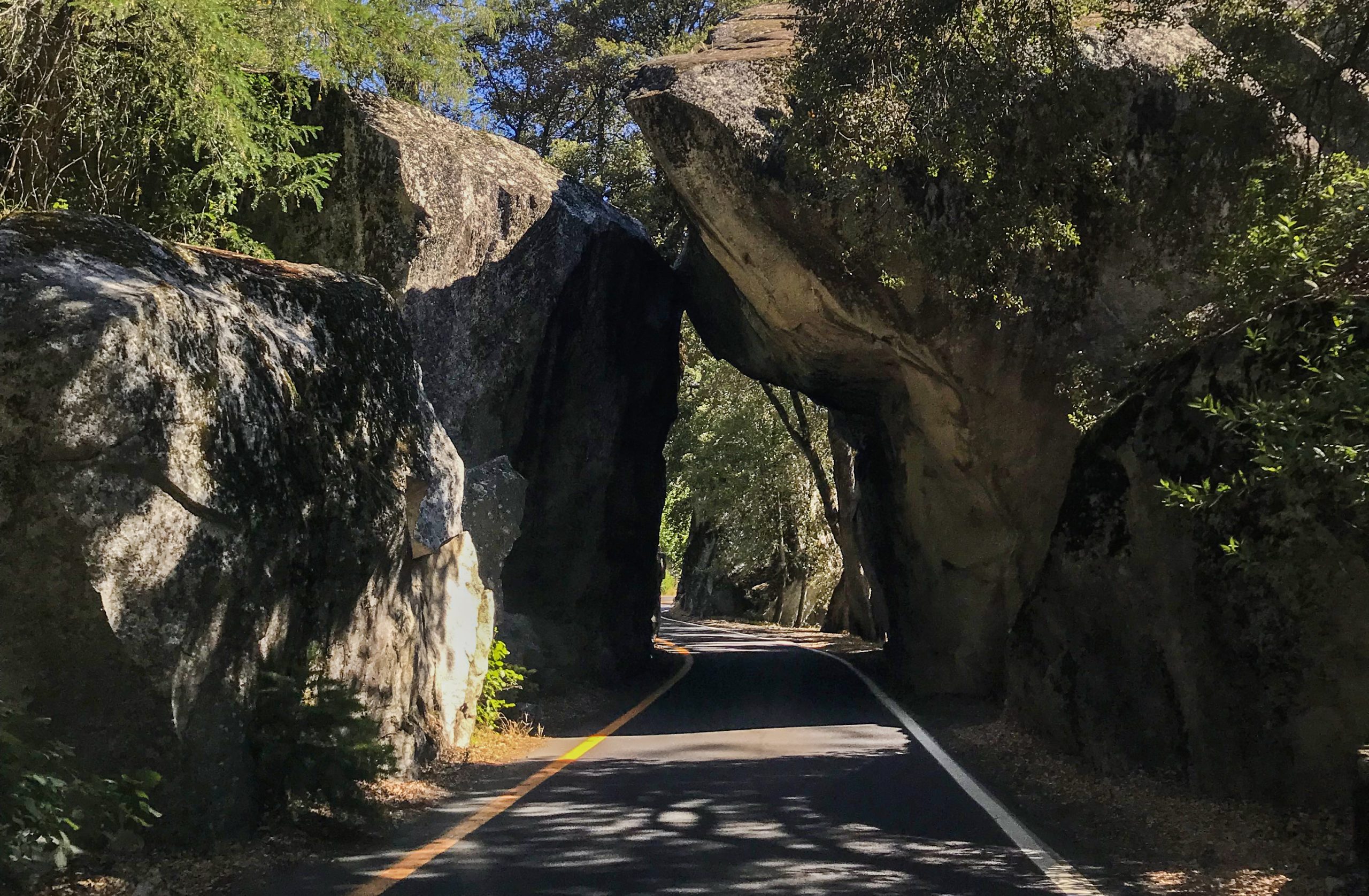
A seven-day pass to Yosemite National Park is $35. You can purchase the pass at the entrance station on the way into the park. If you are just visiting once during the year, and do not plan on visiting any other national parks, this is a great option.
If you plan on visiting Yosemite more than once a year, or if you plan on visiting any other National Parks or federal recreation areas that collect a fee, we strongly recommend purchasing the America the Beautiful Annual Pass for $80 . This has saved us tons of money and time over the years. You can purchase the pass at a variety of retailers, or online (we have purchased ours at REI in the past). For more information about the pass, visit the NPS website here .
The Best Time to Visit Yosemite National Park
Yosemite is beautiful any time of the year, but there are definitely pros and cons to certain seasons. We break down each for you to help you plan your trip.
Spring (April — June)

Pros : The waterfalls flow at full force, and wildflowers blanket a carpet of green in the valley. This is the beginning of hiking season, and a good time to hit the trails before the peak of summer.
Cons : April is a shoulder season, so the scenery is not as spectacular if the leaves and meadows haven’t started filling in with greenery and wildflowers yet. Flooding is a possibility. May and June can be crowded. Tioga Pass and Glacier Point roads may not be open yet, limiting the amount of the park you can access. Mosquitoes usually start coming out in June.
Summer (July — September)
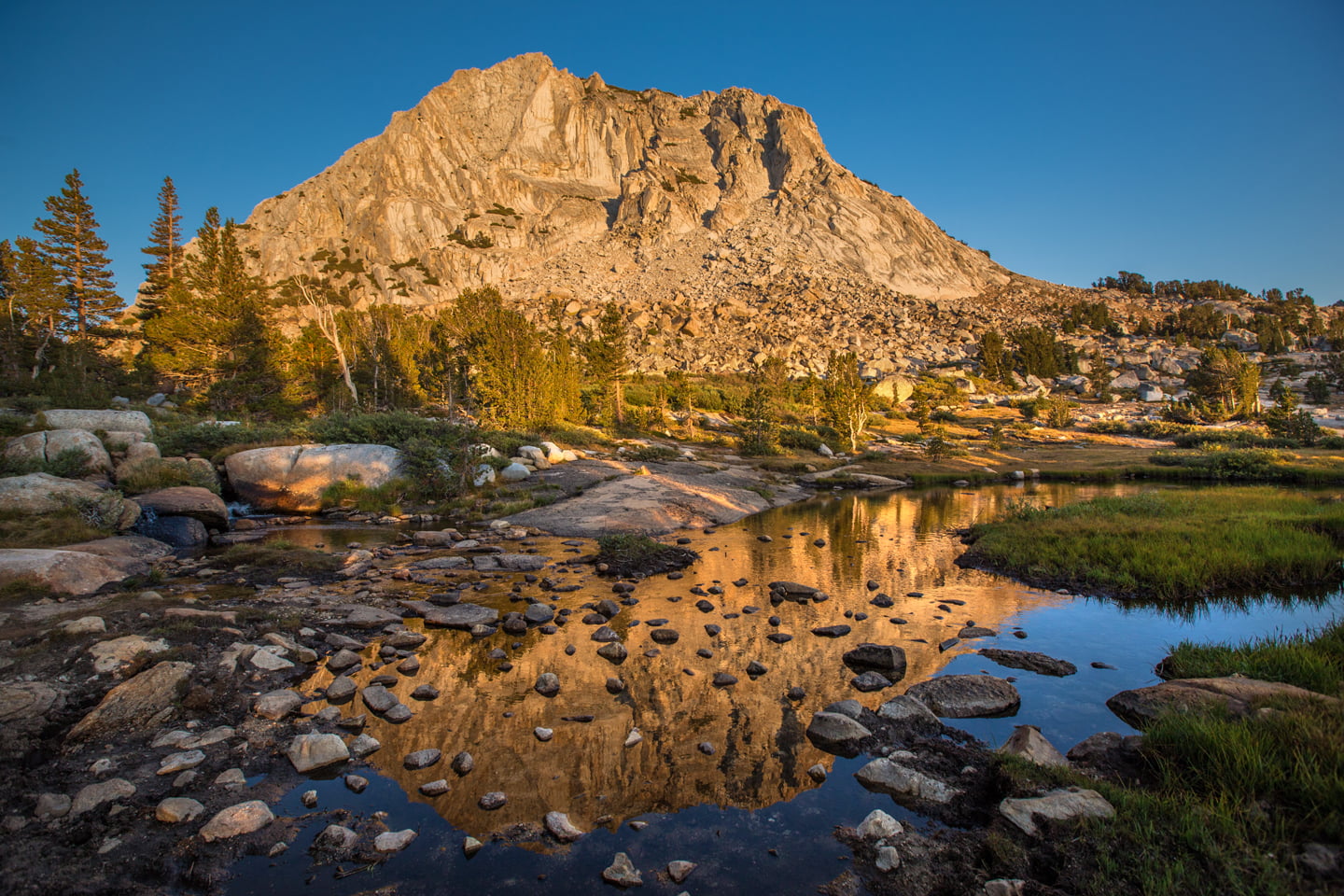
Pros : All trails are open. You can access the high country via Tioga Pass and the Glacier Point Road. Yosemite is truly a hiker’s paradise in summer with endless trails and adventures to explore. This is the time to hit the bigger hikes in the park that may be inaccessible at other points of the year.
Cons : People. There are lots of people. Also, it gets hot and mosquitoes will eat you alive. Depending on the snowpack, waterfalls may begin drying up in early August.
Fall (October — November)

Pros : The crowds die down in fall, the temperatures drop, and if you time the leaves changing, you will be rewarded with some of the most breathtaking fall foliage in the Sierra. This is a great time for hiking, even as the daylight shortens, you can enjoy some of the best the park has to offer. Climbing season begins, so if you want to search for an ant-sized Alex Honnold on El Capitan, you want to come in the Fall or Winter.
Cons : The water levels also drop, so many of the famous waterfalls will be dry or a trickle. Early winter storms may limit travel. The Tioga Pass closes to overnight parking in October, so backpacking can be difficult.
Winter ( December — March)
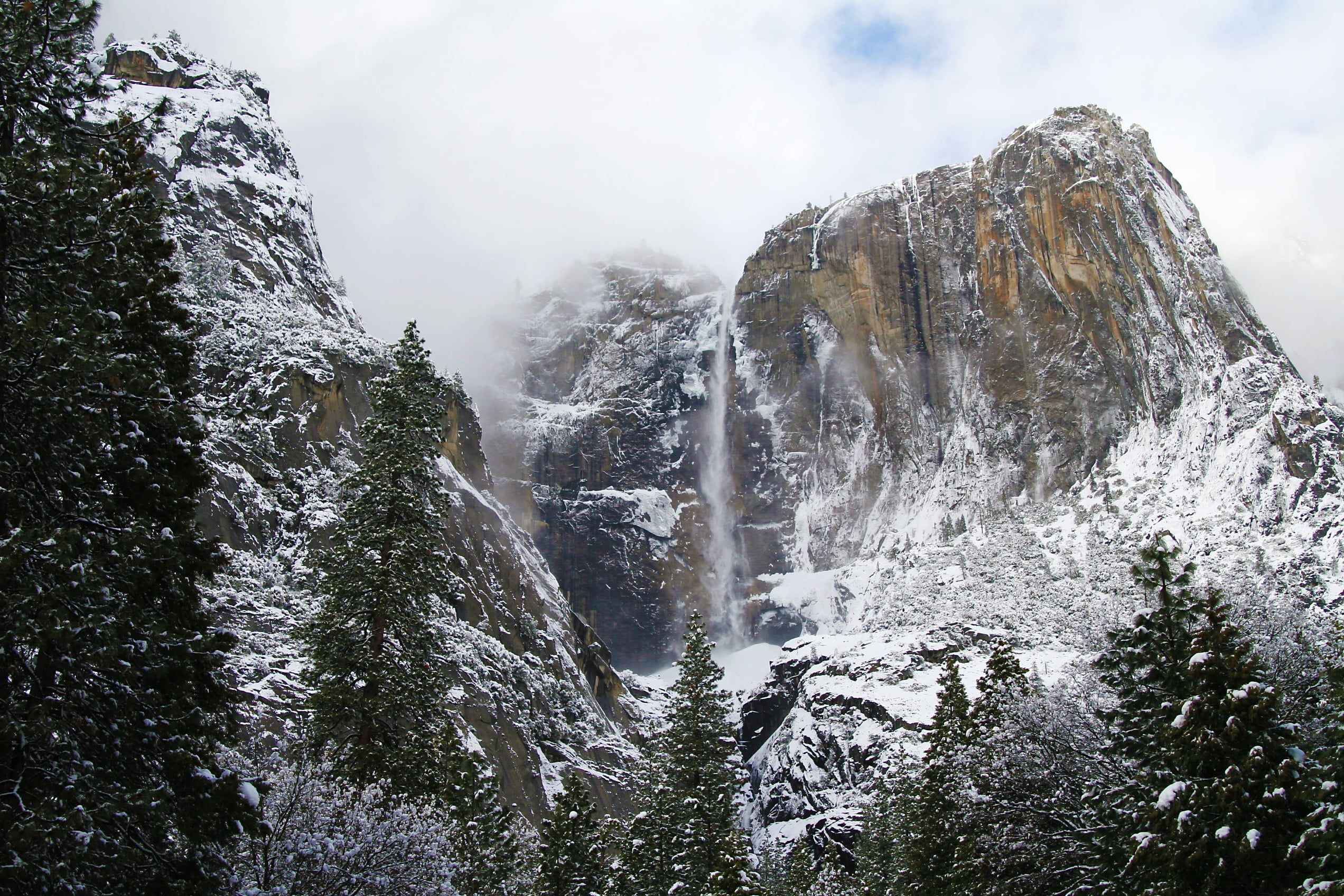
Pros : Yosemite is perhaps the most stunning after a winter storm clears. If you can time your trip right, you will be treated to some of the most jaw-dropping scenery you have ever seen. The crowds continue to be not as bad in winter, and many of the hotels offer packages and discounts if you are able to travel on a weekday. Badger Pass, a small mountain resort, opens for skiing, snowboarding, and snowshoeing.
Cons : Road closures and tire chain restrictions can make winter travel daunting. Parts of the park like The Tioga Pass and Glacier Point will be closed. Many hiking trails will be closed or limited. A big storm could ruin your plans or have you camped out in your hotel room.
The Best Places to Stay in Yosemite
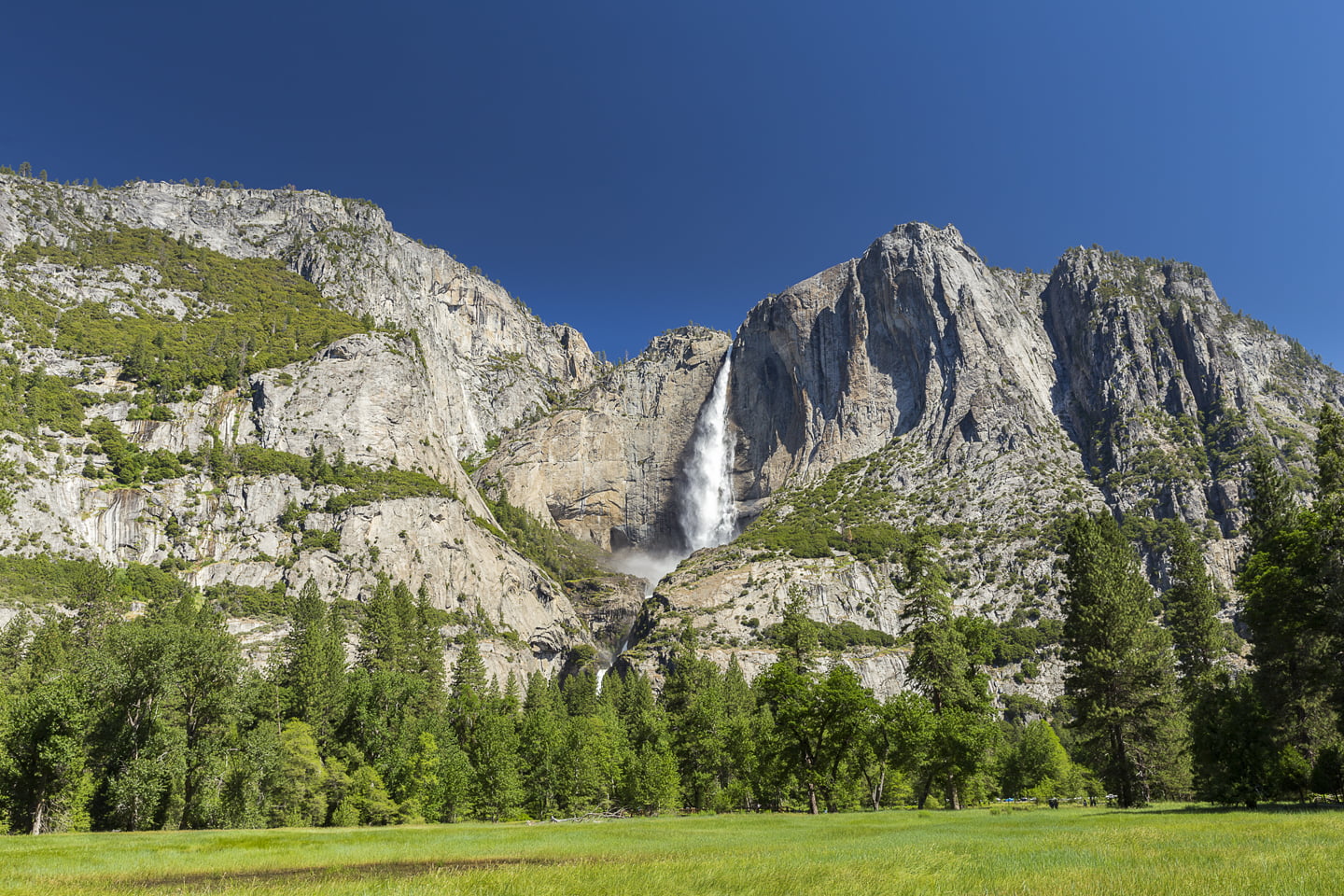
Hotels in Yosemite are expensive, and campsites can be hard to come by if you don’t plan in advance. While there are hotel, campground, and vacation rental options outside of the park, we recommend trying to secure lodging inside if you are able to. This saves travel time each day, and allows you to spend more time exploring the park. Keep in mind that all driving times listed below do not account for weather or entrance station traffic (yet another reason to stay in the park!).
Yosemite Valley Accommodations
We usually try to stay in the Yosemite Valley Lodge due to its central location and price-point. While it is overpriced for the quality of the accommodations and food, it is worth it to us when we wake up to the sound of the falls every morning, and can walk out to fantastic views for sunrise photography.
Other options in the valley include the famous Ahwahnee hotel, or the more modest Curry Village . The latter option has accommodations ranging from hotel rooms to heated tent cabins.
There are four Campgrounds in Yosemite Valley, two of which are open year-round (Upper Pines and Camp 4). All four require reservations May — September, however, the rest of the year Camp 4 allows walk-ups on a first-come, first-serve basis. Keep in mind that you must book reservations online, and when they become available they book up within a matter of minutes. We have heard there are frequent cancellations, so if you are persistent in your search, it is possible to get last-minute bookings. For more information, including booking dates, check out the Yosemite National Park Website .
Accommodations Near Wawona and the South Entrance (Highway 41)
We treated ourselves to a stay at the Tenaya Lodge recently, and really enjoyed the hotel. Located just outside the south entrance of the park, the drawback to staying here was the hour drive on a windy road to the valley.
If you like historic hotels, and don’t mind a bit of a drive into the park, a more modest accommodation in the area is the Wawona Hotel . The hotel is located along Highway 40, and is about a 40-minute drive into the Valley. Be mindful when booking that some rooms have shared restrooms and showers.
El Portal Accommodations (Highway 140)
The Yosemite View Lodge is probably the best option if you are not able to stay inside the park. The hotel is located along the Merced River just outside the Park’s entrance on Highway 140, making it about a 20-minute drive to the valley. The accommodations seem similar to the Yosemite Lodge, at a slightly lower price-point.
Accommodations Near Tuolumne Meadows (Highway 120 East — Summer Only)
There are no traditional hotels in the high county of Yosemite. The Tuolumne Meadows Lodge is the most luxurious of the accommodations in this area, which offers guests heated tent cabins.
There are numerous campgrounds along Highway 120, most of which are first-come, first served. Crane Flat takes reservations, and 50% of the campsites in the Tuolumne Meadows take them as well. For more information visit the Yosemite National Park Website .
Big Oak Flat Accommodations (Highway 120 West)
If you are traveling to Yosemite from the north, you might consider staying at the Rush Creek Lodge or the Evergreen Lodge. The Rush Creek Lodge is a newer hotel located along highway 120, and it is about a 40 minute drive into Yosemite Valley. The Evergreen Lodge is a bit more off-the-beaten-path along the road to Hetch-Hetchy. If you are looking for a quiet place to stay, and don’t mind an hour drive, this is a great option. We stayed here for a night after hiking to Cathedral Lakes for sunset , and really enjoyed the lodge. As an added bonus, the food was the best we have had in the park and surrounding areas so far!
The Hodgdon Meadow Campground is the closest to the Park Entrance if you are traveling from Northern California. Reservations are required April-October, and the campground remains open all year. For more information check out the Yosemite National Park Website .
Vacation Rentals in Yosemite
Within the park, there are three areas of private property that rent out houses and apartments. If you are traveling with a big group, this might be a great option to save on accommodations and prepare your own meals.
Foresta is a small community located off of the Big Oak Flat Road (Highway 120). One of the enticing attributes of this community is that you can sneak a peek of Half Dome and El Capitan from parts of the town. You can see their listings on 4Yosemite .
Yosemite West is located near the turnoff to Glacier Point Road, and The Redwoods are located in the southern area of the park near Wawona. Both are great jumping-off points to explore the southern end of the park, and they are a short drive into the valley.
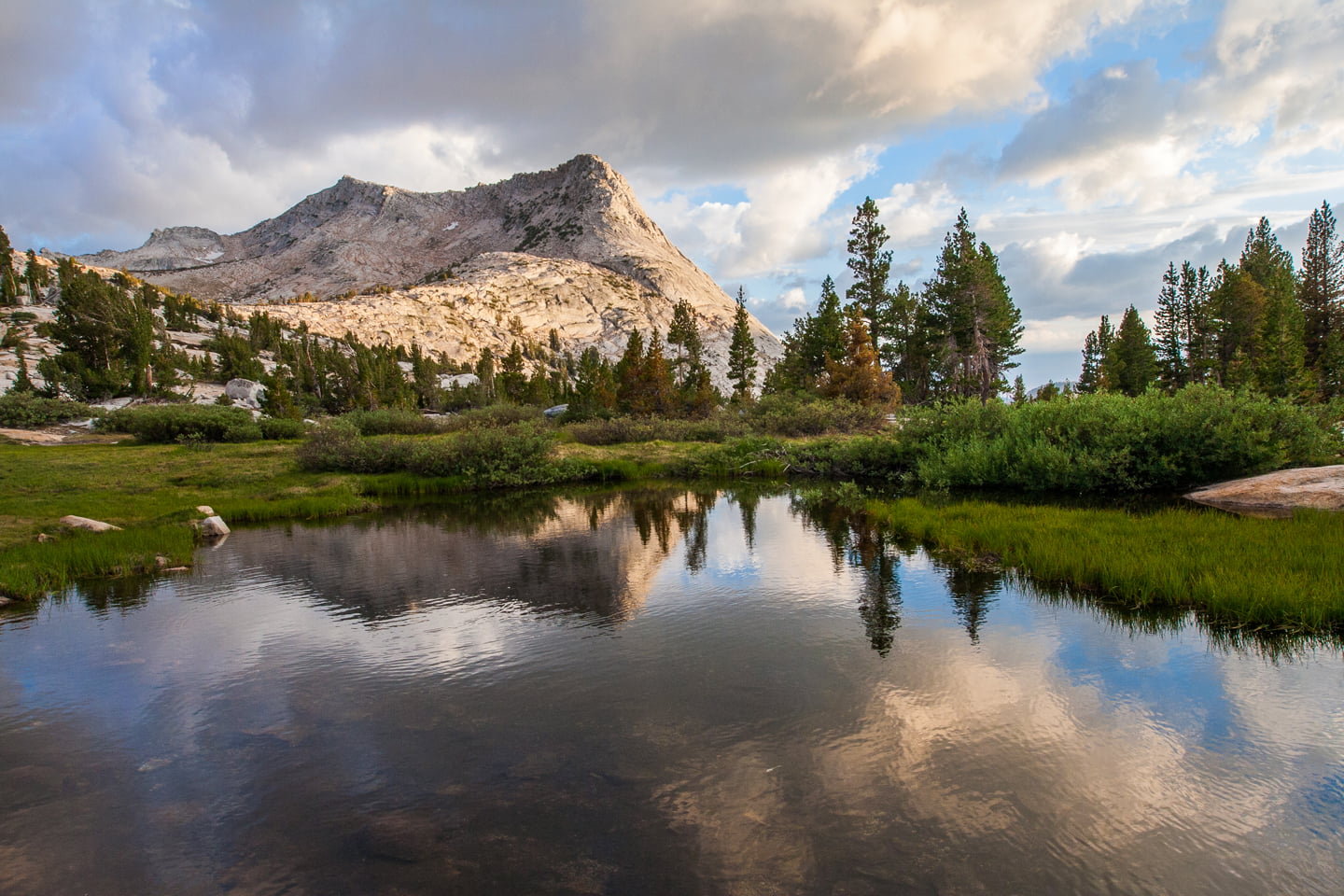
Where to eat in Yosemite
In our experience, the dining options in Yosemite Valley have let us down. Most places are crowded, and the food is uninspiring and overpriced. In addition, there was a infamous food poisoning incident in early 2020 that still has us questioning the food safety practices of their current concessionaire. If you can, bring your own food.
If you can’t bring your own food, there are several dining options in Yosemite Valley ranging from casual, cafeteria-style eateries like the Base Camp Eatery at the Yosemite Valley Lodge, to fine dining experiences like that at The Ahwahnee Dining Room. You can read more about these options, and make reservations (which are recommended for the restaurants the offer table service) here .
If you are having Starbucks withdrawals on your trip, The Yosemite Valley Lodge recently opened one near the main lobby.
If you want to grab cold beer on tap, the Mountain Room Bar at the Yosemite Valley Lodge is a great place to kick up your feet after a long day of hiking. Their fire-pits are especially popular in the cooler evenings.
If you are willing to drive, or are staying outside of the valley we recommend the Whoa Nellie Deli in Lee Vining, and The Tavern at the Evergreen Lodge.
Where to Buy Groceries in Yosemite
The Village Store (Located in Yosemite Village) is the largest market in the park. They have a wide variety of groceries and snacks, as well as fresh meat and produce available for purchase. In addition, they carry basic gear that you may have forgotten to pack, and a collection of souvenirs that you may not have realized you needed.
There are also several smaller shops located throughout the park. More information, including hours and seasonal closures, can be found here .
Yosemite Hiking Guide

If you are planning your first trip to Yosemite, the hiking choices can be overwhelming. We put this guide together to help you pick the best hikes based on your ability. Be sure to click through each link for more detailed trail descriptions and pictures.
Favorite Easy Hikes in Yosemite
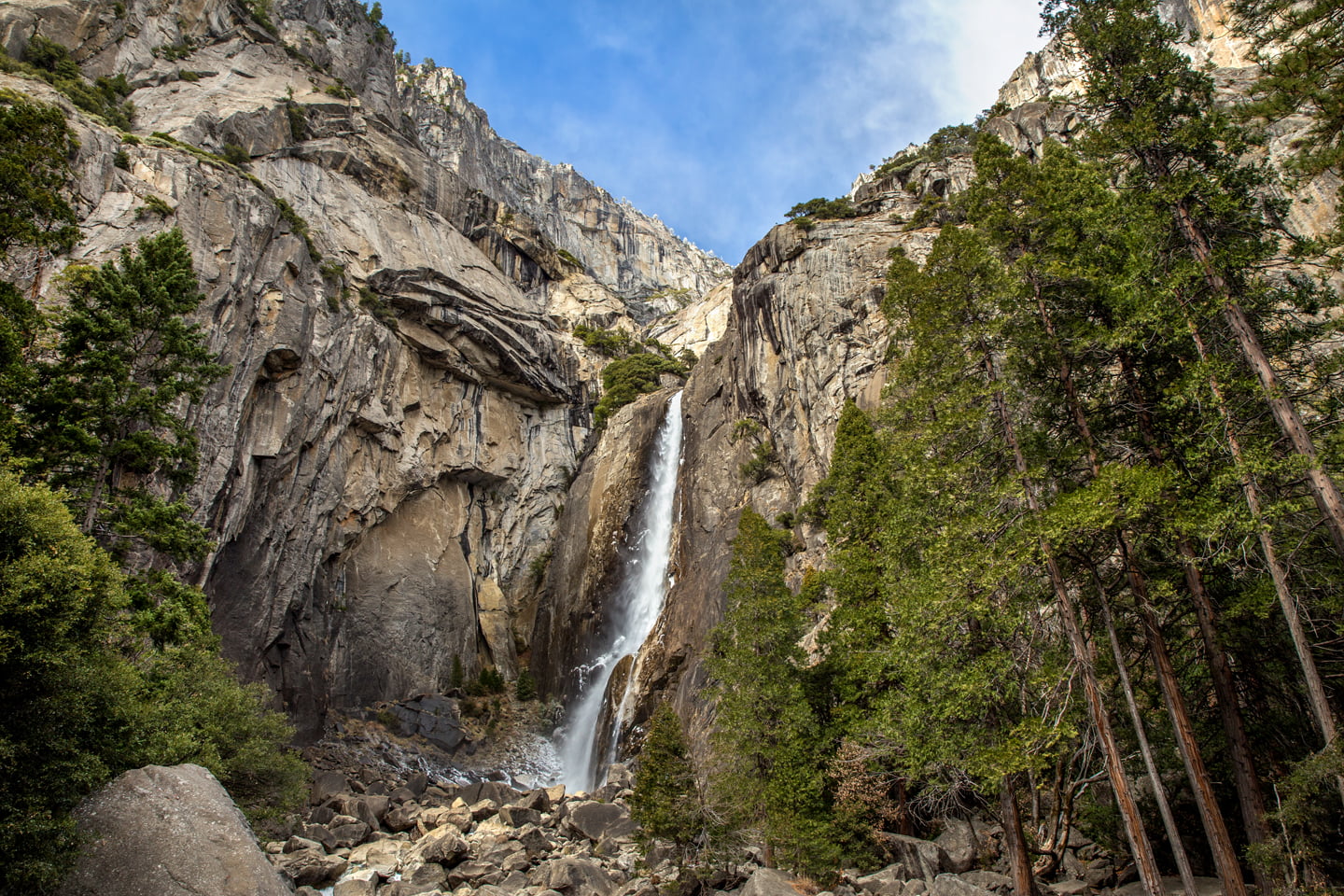
Vernal Falls Footbridge (2 mi): If you aren’t up for hiking the entire Mist Trail, you can gain a peek of Vernal falls by taking this short, but slightly steep hike to a bridge below the falls.
Lower Yosemite Falls (1 mi): This accessible and popular trail takes travelers to the bottom of Yosemite Falls. Definitely get here early to avoid crowds.
Cook’s Meadow Loop (2 mi): A nice, mostly flat trail that takes you through several meadows and along the Merced River with beautiful views of Yosemite Falls and Half Dome.
May Lake (3 mi): This short hike off Tioga Road travels to a beautiful alpine lake and one of Yosemite’s five High Sierra Camps. A higher starting elevation makes this an easy-moderate, summer hike.
Mirror Lake (2-5 mi): One of the most popular, short hikes in Yosemite Valley. Mileage will vary based on which route you take and whether or not you want to do the whole loop. The lake, which is a wide section of Tenaya Creek is a great place to visit in spring and early summer when there is water
Favorite Moderate Hikes in Yosemite

Upper Gaylor Lakes (3 mi): A short hike accessible from the Tioga Road. Rated moderate because the beginning takes you up a steep slope that is quite tiring when combined with the higher starting elevation.
Top of Lower Yosemite Falls (3 mi): This trail is short, but the 1,000 ft gain in the first mile will give you a pretty good workout. Once at Columbia Rock, you will be rewarded with unique views of Half Dome, and just around the corner the top of Lower Yosemite Falls is a sight not to be missed.
Taft Point and Sentinel Dome Loop (10 mi): Some of the best views in Yosemite are found on this trail that takes you to several vistas along the valley’s south rim. While the distance may seem long, there isn’t much elevation gain. You can also shave distance off by doing each point as an out-and-back from the parking lot.
Wapama Falls (5.2 mi): Located in the Hetch Hetchy section of Yosemite, this easy-moderate hike is a seasonal treat in spring and early summer. The falls rival many of their more well-known neighbors in Yosemite Valley. If you’re going to do one hike in Hetch Hetchy, make it this one.
Favorite Difficult Hikes in Yosemite

Cathedral Lakes (11 mi): A high altitude trek to two alpine lakes that lie in the shadow of a craggy granite spire. This hike isn’t especially strenuous, but starts at a higher elevation (near 9,000 ft.) which can make it tougher if you are starting your day at sea-level.
Vernal and Nevada Falls (9.7 mi): One of our favorite hikes in the Yosemite Valley. This loop takes you up the aptly named Mist Trail alongside two waterfalls, and down the famous John Muir Trail with beautiful views the whole way.
North Dome (9 mi): A hike that is about the destination and not so much the journey. This trek through the woods ends on the edge of the valley rim with a fresh look of Half Dome face-on.
Favorite Strenuous Hikes in Yosemite

Upper Yosemite Falls and Yosemite Point (8.5 mi): A leg-burning climb up the valley’s northern rim. The views will fuel you though, and the reward at the top makes this trek a worthy adventure.
Four Mile Trail to Glacier Point (10.5 mi): Spectacular views of Yosemite Falls make this tough trek to Glacier Point worth your time. One of the preeminent hikes in Yosemite National Park.
Stanford Point (10.6 mi): A relentless climb from Tunnel View up to the valley rim takes you to a bird’s-eye view of the popular vista below.
Cloud’s Rest (14.5 mi): A high country adventure to a granite vista behind Half Dome. Most hikers who have made the journey say that this is the ultimate view of Yosemite Valley.
Half Dome (16 mi): Making it to the top of Half Dome is on almost every hiker’s bucket list. This strenuous, and dangerous, hike takes you from the valley floor, past two of Yosemite’s famous waterfalls, and up the backside of the park’s most famous landmark. You will need courage and a permit to go on this adventure, so make sure you have both before you hit the trail. More information about the Half Dome permit system can be found here .
Other Yosemite Adventures
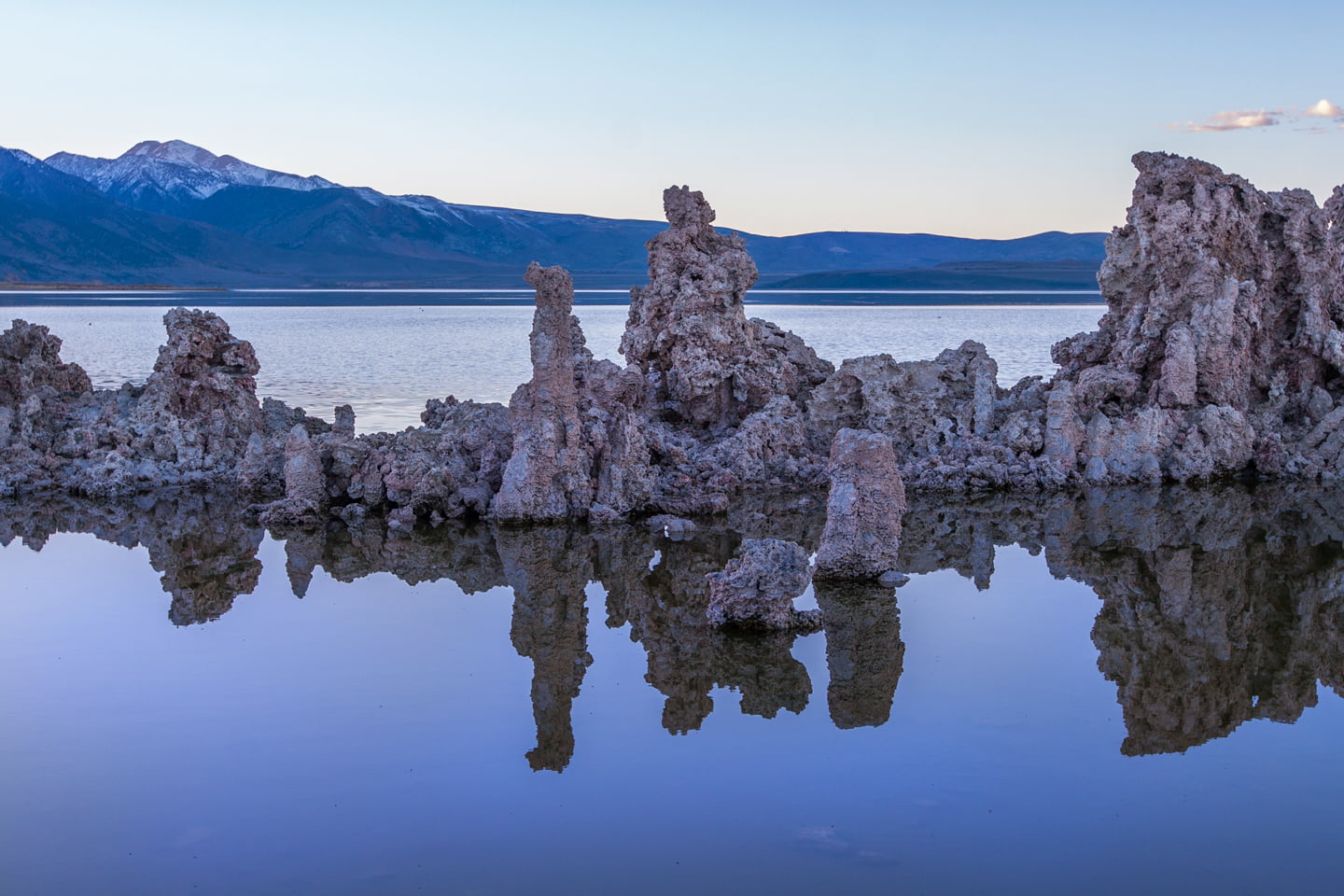
Visit the Giant Sequoia Trees in the Mariposa Grove
If you have never seen a giant sequoia in person, don’t miss this opportunity! The scale of these ancient trees is something no photograph could ever capture. You just have to stand below them in person and see for yourself. This area has no shortage of hikes to explore: You can do a 7-mile loop through the entire grove, or a .3-mile Big Trees Loop.
Take a Scenic Drive over the Tioga Pass
This one of our favorite drives in California. The views of the Yosemite high country are stunning: pine forests, green meadows, alpine lakes, and craggy peaks. Additionally, the Eastern Sierra is worth visiting if you have the time. I wouldn’t miss Mono Lake, or a quick drive through the June Lake Loop ( a must-visit for fall colors! ).
Snowshoe to Dewey Point in Winter
This is one of the best things to do when visiting Yosemite in the winter. You can drive, or take a shuttle up to the Badger Pass Ski Area, and rent snowshoes. The trail to Dewey Point is well-marked, and traveled, and the views from the vista give you a unique perspective of El Capitan from head-on.
Backpack through the High Sierra Camps
This is a great introduction to backpacking as you don’t have to worry about bringing a heavy pack filled with supplies for overnight camping. The High Sierra Camps are a series of alpine retreats that include tent cabins and a dining hall. So, you can pack your day pack, and travel between them at your leisure. Julie and her family visited three of the camps several years ago, and still relish in the memories of their trip adventures.
Photographing Yosemite

Yosemite has some of the most iconic locations for landscape photography. Since the valley is on the Western side of the Sierra, most of the park looks best at sunset. We recommend Tunnel View, Valley View, and Glacier Point for watching the last light of the day illuminate the granite rocks.
Sunrises can be stunning in these locations too, but usually only if there are clouds present to pick up color. Morning light illuminates Yosemite Falls the best about an hour after sunrise. There are also some beautiful locations along the Merced River that catch the early rays of the sun. We recommend walking around the Valley Loop Trail and exploring!
How to Avoid Crowds in Yosemite
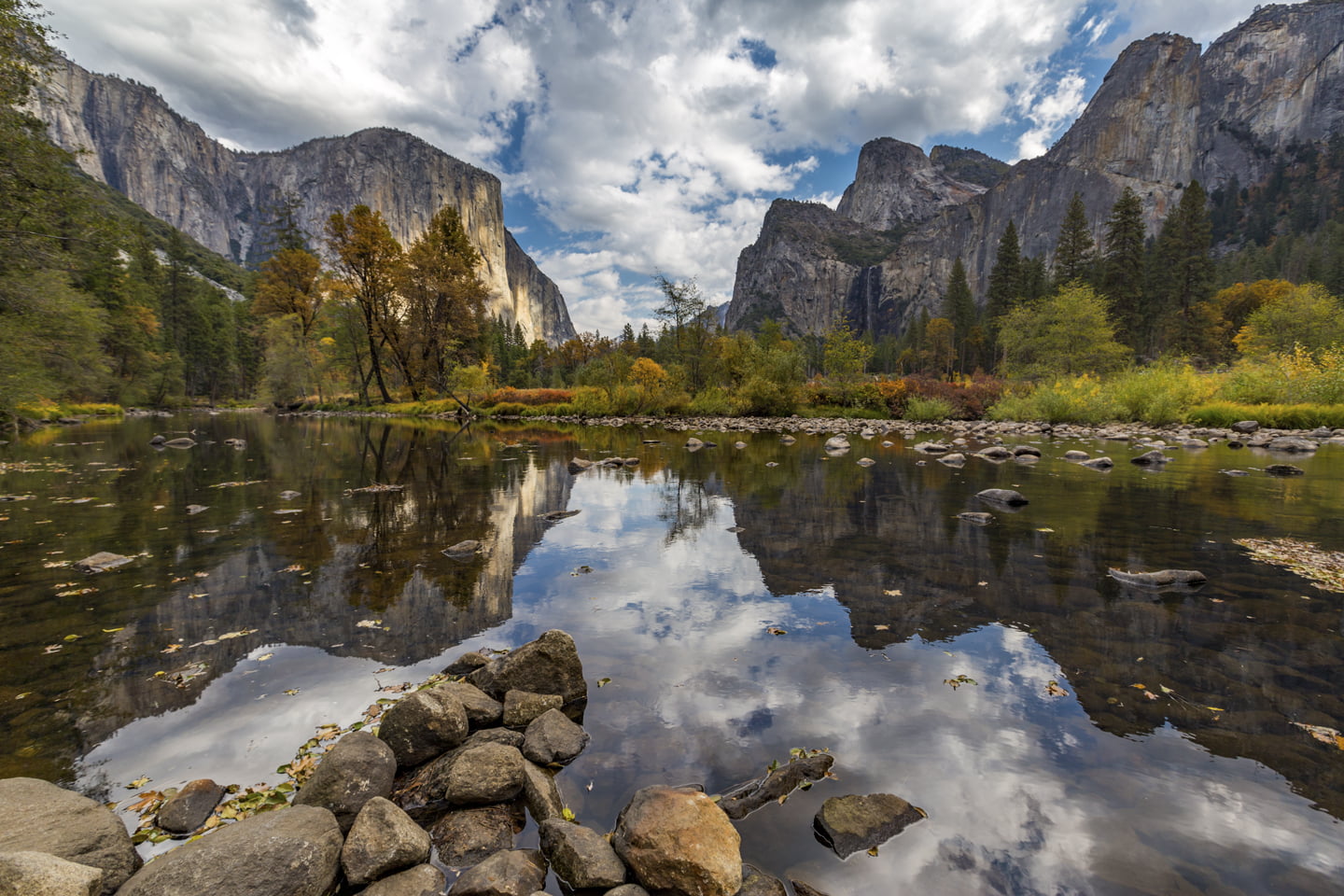
1. Get up early! People start arriving and hitting the trails around 8:00 a.m. Get a head-start by setting your alarm.
2. Visit October — April to avoid the summer crowds. If you can visit on a weekday that’s even better!
3. Explore lesser-known areas. Tuolumne Meadows is less crowded than Yosemite Valley in the summer and has arguably more beautiful scenery. The Hetch-Hetchy Valley is also a hidden gem that not many people frequent.
4. If you want to see the giant sequoia trees, visit the Tuolumne Grove or the Merced Grove instead of the Mariposa Grove. While it is bigger, and more accessible, the Mariposa Grove is much more crowded.
5. Avoid going in February during the Firefall phenomenon. Social and print media have highly publicized this event, and now so many people flock to see it that the park becomes extremely crowded for two weeks in February. While it is beautiful to witness first-hand, the road closures and access restrictions make it an unpleasant time to visit.

What to see if you only have one day in Yosemite ?
If you only have one day to explore Yosemite, here are the best roadside views not to miss:
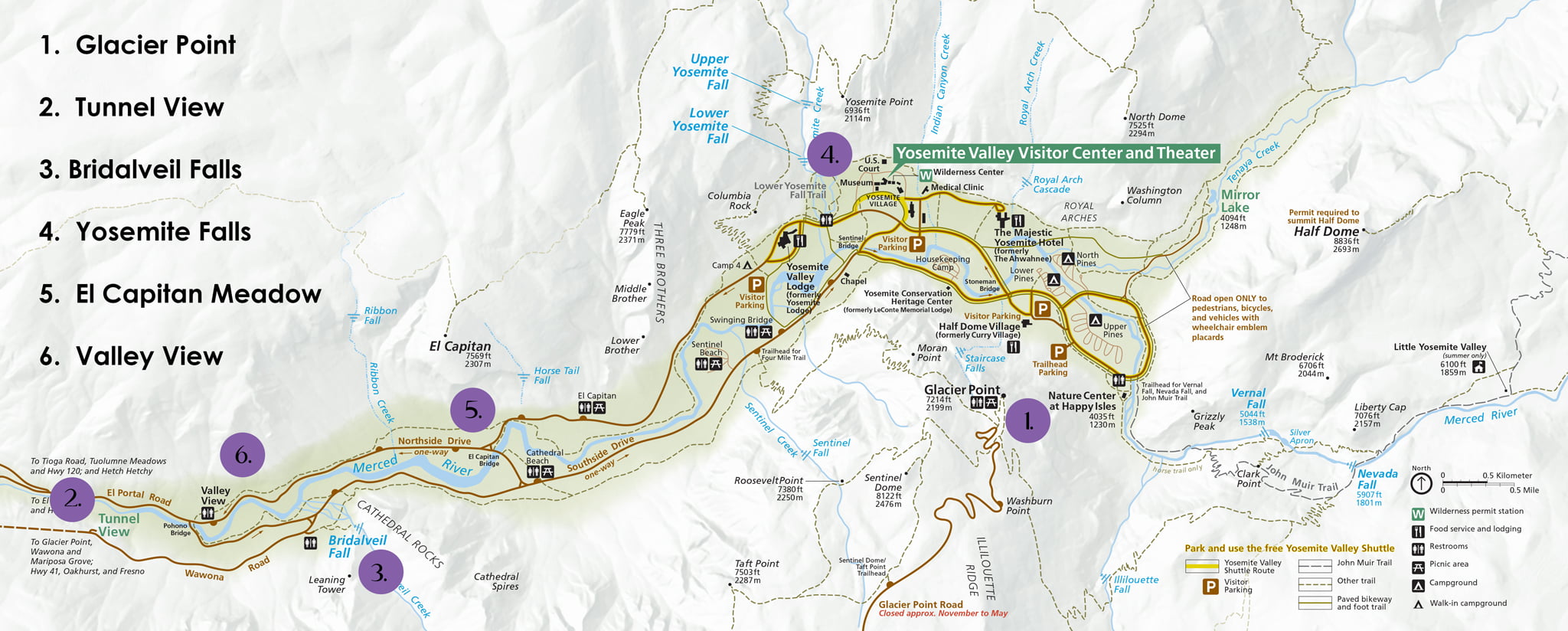
More Planning Resources
We highly recommend purchasing a trail map if you are doing any sort of extensive hiking. We frequently use the Day Hikes of Yosemite National Park Map Guide that was put together by Jake from Hike 734. His insights as a hiker, and passion for the outdoors make this a reliable and insightful resource.
When Julie first started pursuing landscape photography, she purchased Michael Frye’s The Photographer’s Guide to Yosemite . It has been a great resource over the years as it offers seasonal tips about lighting conditions and photography locations.
Yosemite Packing List
Clothing: Be sure to dress in layers as the weather in the mountains can change quickly. Moisture-wicking material is important for any physical activities you may do, and it’s a good idea to carry a rain jacket , even in summer. You will want to be prepared for hot days in summer, followed by cooler evenings. In the Spring and Fall temperatures vary (usually mild/warm days followed by cold nights), so check the weather ahead of time and bring a variety of layers. In the winter, be sure to bring extra layers to protect against snow.
Footwear: Make sure you have comfortable footwear with a good grip. We recommend the Aku Alterra hiking boots, or a pair of trail runners like these Hoka One One Challengers . Don’t forget that wool socks are important too for wicking moisture and preventing blisters. We love the Darn Tough and Smartwool brands. In winter, a pair of micro-spikes are essential for hiking and can even be necessary on sidewalks in the valley.
Hiking Backpack: If you are planning on hiking, you will need a day-pack to carry water and snacks. Brian loves this one from Gregory because it distributes the weight well, and Julie uses this Osprey pack because it works well for her photography gear.
Hiking Poles help with stability and prevent soreness and injury. We love our Black Diamond Trail Ergo Cork Trekking Poles .
Sun Protection: The sun is harsh in the mountains, so make sure you are prepared with sunscreen , SPF chapstick , and a hat .
Bug Protection: In the spring and early summer you may encounter mosquitoes. Be sure to have some sort of repellent like picadarin or deet on hand, and you might also consider a face net .
A First-Aid Kit: You can never be too prepared when visiting the outdoors. We like this travel-size kit so that we can put it in our day pack on hikes. We have definitely used it a few times, and were glad to have it handy.
Hydration: Make sure you bring plenty of water on any hikes you plan to do in Yosemite. We recently switched to the Platypus bladders and love them. For longer hikes, we often bring along a couple of extra Nalgene bottles filled with water or an electrolyte mix.
Snacks: Some of our favorite high-energy snacks include GU (Salted Caramel is a favorite) and Cliff Shot Blocks (We love Mountain Berry and Ginger Ale).
Be sure to check out our posts: Summer Hiking Gear and Photography Gear for more tips on what to pack for a trip to Yosemite.
Yosemite Frequently Asked Questions
Are dogs allowed in Yosemite?
Yes, but with some very important exceptions. Dogs must stay in established areas, paved paths, and are not allowed on any hiking trails or walk-in campgrounds . For those traveling with their furry friend, consider places like the Yosemite Valley Loop, Lower Yosemite Falls, Glacier Point and similar options. Be sure to store their food in bear boxes as you would your own food and check this page for additional information.
I have limited mobility, are there options for me?
Yes! So much of Yosemite can be enjoyed just be driving through the park and stopping at iconic viewpoints. You can utilize our guide for visiting the park in one day above as a reference point as all of these stops offer quintessential Yosemite views and are accessible. And don’t limit your visit to Yosemite Valley! If you are coming to the park during the summer, be sure to drive up to the High Country for more stunning scenery. Additional information can be accessed through the park’s extensive accessibility guide .
Can I travel to Yosemite with my RV?
Absolutely! Be sure to take it slow, and use pullouts for faster traffic to pass, as many of the park roads are at a lower speed to begin with and some are especially windy. There are 10 Yosemite campgrounds that allow RV parking, and reservations are strongly encouraged — particularly during the summer peak season. Keep in mind that roadside camping within the National Park is illegal and you must stay in an established campground. Additional information, including road restrictions for RVs can be found here .
Is there cell service and WiFi in the park?
Yes and no. We have found that the best cell service tends to be in the established areas of the park such as Yosemite Village, but it is by no means robust. WiFi is available for guests at the Yosemite Valley Lodge, The Ahwahnee Hotel, Curry Village and the Wawona Hotel, and can also be found at Degnan’s Kitchen. In our experience the speeds are pretty abysmal, so don’t plan to stream any movies or have that Zoom call you were hoping for. For more information on carrier details, check this link .
Can I ride my bike or rent one in Yosemite?
Yes! There are a dozen miles worth of paved trails in Yosemite and riding through the Valley is a popular choice for families during the summer. Be sure to follow all the rules of the road and remember that off trail biking is not allowed. If you don’t have a bike, they can be rented from Yosemite Valley Lodge or Curry Village. More information including rental rates can be found here .
Does Yosemite offer tours if I want to be led by a guide?
They do! While we haven’t personally taken a tour of the park since we’re locals, we have heard positive feedback. Tours are great for those who are looking to see the park, learn the history, and not have to worry about transportation. You can find information on Yosemite tour options here .
Can you plan our trip for us?
We hope that you have found our comprehensive guide to visiting Yosemite useful in your planning! If you would like a personalized itinerary, feel free to send us a message and we would be happy to discuss some options with you!
Your Yosemite photos are stunning, do you offer prints?
Yes! Julie sells her landscape prints which come in a variety of sizes and prices. For more information, click the link here or send us a message !
Extending Your Trip to Yosemite
There are not shortage of beautiful places to visit in California. Here are some of our favorites that you could easily visit if you wanted to extend your trip to Yosemite.
Visit Sequoia National Park
Visit Pinnacles National Park
Visit Redwood National and State Parks
The Ultimate California Road Trip
Road Trip to the Shasta-Cascade Region
Save This Post for Later
26 thoughts on “yosemite trip planner”.
Thanks a lot for this article, for all the recommandations. The pictures are amazing. I really hope I can visit your beautiful country one day 🙂
We’re so glad you found it valuable, Agathe! Hopefully you get a chance to come visit soon! 🙂
Wow! That first sunset photo just took my breath away! And the Valley View is also spectacular! But more important, thank you for the incredibly insightful information provided in this post and the packing list is especially useful!
Thanks Michelle! We’re glad you found the information useful and hope you get a chance to visit Yosemite in the near future.
Love this! It’s so detailed and your pics are gorgeous! As a frequent visitor to Yosemite I would also recommend the Hodgdon Meadow Campground. It’s half way between the valley and Tioga Pass, so much less crowded, very quiet and still in the park. Also, a few miles past Mono Lake is a very cool ghost town, Bodie, CA.
Thanks Carrie! We haven’t made it to Bodie quite yet, but it’s on our list and we’ll be sure to add it once we do. Hope you get a chance to visit Yosemite again soon!
We have been thinking of Yosemite for some time now. With air travel being a bit sketchy, we are looking at future road trips and have moved Yosemite up on the list. This post is super helpful in planning! Thank you!
You’re welcome, Jenn! Yosemite is honestly one of our favorite places to visit and a road trip is the perfect way to enjoy the park. We hope you get a chance to make it there very soon!
I have always wanted to go to this park! looks so incredible! great pics BTW
Thanks Maria! I hope you get a chance to visit Yosemite sometime in the near future!
Wow, thanks for all the tips! I love your seasonal breakdown tips. There are definitely pros and cons to the various seasons. Even though we haven’t been to Yosemite, I agree with you about staying inside the Park. Last summer we went to Yellowstone and it would have given us extra hours to explore if we had booked a room inside the park. Keeping our fingerscrossed we get to Yosemite soon!!!
You’re welcome! We hope you get a chance to visit Yosemite soon, it’s definitely worthy of a road trip! When we visited Yellowstone in 2017, we stayed at Headwaters at Flagg Ranch and were outside of the park as well. It made our days longer with the added time driving into and out of the park. In the future, we would stay at a hotel or camp somewhere in the park, and find that strategy works well for Yosemite too!
I want to visit Yosemite so badly! Every photo I see of the park is so beautiful and hiking around there would be amazing. Can’t wait to visit one day and see Half Dome in person 🙂
It’s definitely a place that you have to experience! One of our all-time favorite destinations and we’re fortunate to live close enough to keep coming back time and agin. Hope you get a chance to visit!
We have long wanted to visit Yosemite but have never made it. Your photos definitely show all of the beauty that there is there.
Thanks Michelle! I hope you get to visit Yosemite sometime soon!
I haven’t been to Yosemite yet and your pictures make me want to book a trip tomorrow! Incredible. It looks like it would be great to visit any time of the year — but which time of the year is your favorite?
Thanks Pam! It’s so hard to pick a favorite season in Yosemite because each one offers something different. Spring and Fall are probably the top choices for us, if we had to pick. Spring means the waterfalls are flowing and the crowds are still not at their peak. Fall brings beautiful colors and less people, plus the days are cooler and you can typically still access the high country. Whatever you choose, Yosemite will be special!
This is such a valuable resource! Typically, I don’t travel to national parks because I don’t even know how to start with planning. But, Yosemite has been really high on my list, I talk about going with my parents all of the time because it’s one of their dreams. This is the first resource I’ve come across that is well organized and easy on the eyes visually. I’ll be saving this for next summer! Thank you!
Thanks so much Stephanie, we’re glad you found it useful! Hope you make it out to Yosemite next year and do let us know if you have any questions. It’s one of our all-time favorite places and you’ll have a great time when you go!
Yosemite has been on our list for years but we have yet to visit. I know that I couldn’t handle the cold, and it always seems to be too expensive during the summer. Maybe I can make it happen in fall or spring! Regardless, I will be saving your post to help in my planning! Thanks so much!
Spring and Fall are both great times to visit Yosemite! We recommend May since the waterfalls are flowing and most of the hiking in the park is accessible. Hope you get a chance to visit soon!
Yosemite is so beautiful! I miss living just a few hours away and being able to visit in the spring when the wildflowers are blooming and the waterfalls are flowing!
It really is! We love that we can drive out to the park and spend the day and return home and Spring is one of our favorite times to visit!
Since I’m not driving, it’s always a bit difficult exploring places like these in the United States. However, I’ve visited Yosemite on a day trip, and it was very impressive. On the other hand, it was also one of the most expensive day trips I ever took — although it was far from a private tour. Nope, a coach full of crazy Europeans who are not driving. I still love to look at my pictures of those imposing rocks — and, obviously, I’ve enjoyed your pix, too 😀
Thanks for sharing your experience visiting Yosemite, Renata! Glad to hear you were able to enjoy the park without having your own vehicle and that you enjoyed our photos!
- Privacy Policy
Entry reservations no longer required: A beginner’s guide to visiting Yosemite National Park

Editor's Note
Few national parks loom quite as large as Yosemite National Park.
Located in the High Sierra of Northern California, Yosemite is one of the country's oldest and most visited national parks. Outdoor adventurers and nature lovers flock to the natural wonders of Half Dome, El Capitan and the park's many waterfalls .
I began visiting Yosemite with my husband nearly two decades ago, not long after he finished a summer working in the park's High Sierra Camps in college. After moving to the San Francisco Bay Area just 3.5 hours away, we returned for a number of visits in the years that followed. We recently took our kids with us for their first Yosemite trip last summer when the park reopened after its COVID-19 closure.
If you've never been to Yosemite National Park, here's everything you need to know to plan your first visit.
For more TPG news delivered each morning to your inbox, sign up for our daily newsletter .
Yosemite National Park basics

At nearly 1,200 square miles, Yosemite is one of the larger national parks and definitely deserving of much more than a day trip. The park averages between 4 and 5 million visitors in a typical year, making it one of the most visited national parks in the U.S.
The park is best known for its many waterfalls and granite monoliths like Half Dome and El Capitan, which climbers dream of conquering . Yosemite also has a number of epic hiking opportunities as well as abundant wildlife, including bears that are masters at breaking into cars if you dare leave any leftovers behind.
Yosemite entry costs $35 per vehicle. Consider purchasing an America the Beautiful annual pass if you plan to visit a few other national parks or public lands within the same 12-month period. At just $80, it's a solid value and a great way to visit the nation's parklands for less . Also, remember that 4th graders get free entry to national parks if they register with the Every Kid Outdoors program .
The park was closed for several months in the spring of 2020, but it reopened in June under special coronavirus restrictions. Visiting Yosemite during COVID-19 definitely means a few differences from usual operations, but those differences are overwhelmingly positive.
Advance park entry reservations were previously required for anyone not staying in lodging located within the park's boundaries, but as of March 1 , that's no longer the case.
Related: 7 trips to take right now if you want to escape the crowds
How to get to Yosemite National Park
Yosemite National Park is enormous, so before you decide how to get there, you need to decide which parts of the park you want to visit.
Most first-time visitors head to the Yosemite Valley, taking either Highway 120 or 140 into the park from the west. There's also a south entrance at Wawona, an entrance on the northwest into the Hetch Hetchy Valley and an eastern entrance at the Tioga Pass that's only accessible in the summer.
The closest airport to the park that offers a reasonable amount of commercial service is in Fresno, California. The Fresno-Yosemite Airport (FAT) is approximately a 1.5-hour drive to the southern entrance at Wawona or 2.5 hours into the Yosemite Valley.
Many visitors arriving by air opt to fly into one of the San Francisco Bay Area's airports, which offer more airlift and usually cheaper fares. Oakland International (OAK) is the closest at 3.5 hours away from the valley, but San Francisco International (SFO) or Mineta San Jose International (SJC) are both viable options at about 4 hours away.
Related: National parks are reopening: Here's everything you need to know to plan a trip
Top things to do and see in Yosemite National Park
Given its size, it really does take nearly a full week to get a glimpse at the entirety of the park.
Yosemite Valley
If you only have a day or a weekend, the most popular area of the park is the Yosemite Valley. Here you'll find creature comforts like shorter paved trails, restaurants, stores and car-accessible stops. But some incredibly challenging hikes start here as well, so more adventurous travelers shouldn't write off the valley.
You can take a shuttle around the valley or walk or bike parts of it, though the shuttle is not running during coronavirus restrictions. Some of the highlights in the Yosemite Valley include:
- Tunnel View : The car pullout at Tunnel View on Highway 41 offers the quintessential Yosemite backdrop for a photo, with El Capitan and Half Dome in view.

- Bridalveil Fall : Stroll a half-mile on a paved (but not wheelchair accessible) trail to view this famous waterfall.
- Sentinel Beach : In the summer months, set up a towel on the banks of the Merced River that flows through the valley. Sentinel Beach is one of the top spots for wading or tubing when the water isn't flowing too fast.
- Mist Trail (Vernal & Nevada Falls) : The Mist Trail is one of the most popular hikes in the valley, ascending up two waterfalls. The roundtrip climb is 5.4 miles and fairly strenuous due to elevation changes. If you aren't up for a full day hike, consider doing the round-trip to the footbridge that offers views of Vernal Fall. It's less than a mile each way but is rated as a moderate hike due to the vertical climb (my 6-year-old did it, but not without some complaining and a few breaks).

- Yosemite Falls : One of the easier and most popular hikes in the valley is the stroll to Lower Yosemite Fall. The 1-mile loop is paved and mostly stroller and wheelchair accessible. Hikers looking for a bigger challenge can ascend the longer trail to the top of the upper fall, a 7.2-mile hike with 2,700 feet in elevation change.
- Mirror Lake : One of the most photographed spots in the valley is the reflection of Half Dome in the water at Mirror Lake (which becomes Mirror Meadow later in the summer and fall when the water recedes). Take the short interpretive nature path to view the closer end of the lake, or hike the mostly flat longer trail that circumnavigates the water.

- Half Dome : Ascending Half Dome is a bucket list hike for many travelers. But at 14 to 16 miles round-trip, it's one of the most strenuous hikes in the park and requires substantial preparation. In order to prevent overcrowding on the cables that help hikers climb the last part of the trail, the park instituted a permit system a few years ago. You must now enter a lottery in March each year for a chance to hike Half Dome.
Glacier Point

Perched high above the valley floor is one of the park's most popular drives to Glacier Point. Even though Glacier Point is only a few miles from the Yosemite Valley, the drive itself takes 45 minutes to an hour from Yosemite Village due to the elevation change.
Glacier Point has a short, easy trail from the parking area to a variety of lookout points. Both a side view of Half Dome as well as Vernal and Nevada Falls are visible.
Parking can be a major challenge at Glacier Point, so when shuttles and tours are running again, shared transportation is the preferred way to see it. Taking a shuttle to the top is also the best option for hikers who want to take one of the many trails down into the valley. In particular, the Panorama Trail (8.5 miles) and Four Mile Trail are popular options. Some more ambitious hikers will take one of those trails up and the other down!
There are other hikes available on the road to Glacier Point as well. In particular, the trailhead about a mile from the top of Glacier Point is an excellent choice for the moderately adventurous, with 2.2-mile hikes leading to either Sentinel Dome or Taft Point.

For now, during COVID-19 restrictions, shuttles are unavailable, but there's ample parking at Glacier Point for the park's limited number of visitors. Note that the road to Glacier Point will be closed all of 2021 to make improvements.
Mariposa Grove
One of the draws of California's outdoors is its enormous and imposing trees . The giant sequoias located at Mariposa Grove are excellent specimens. The famed Grizzly Giant and California Tunnel Tree that visitors can walk through are just two of 500 trees protected within this area of the park.
Under normal park conditions, there's a shuttle from the Mariposa Welcome Center that delivers guests to an arrival area. There are a variety of trails that originate here, including the easy Big Tree Loop (a third of a mile) or the moderate 2-mile Grizzly Giant Loop Trail. During COVID-19 restrictions, however, your only option is to hike 2 miles each way from the parking area to the arrival area, making hikes here a much longer time investment.
Tuolumne Meadows & Tioga Road
Visitors looking to escape the hustle and bustle of Yosemite Valley often head for Tuolumne Meadows. Located past the Big Oak Flat entrance to the park on Highway 120 along Tioga Road, this high elevation alpine meadow area is accessible only in the summer and early fall.
After leaving Crane Flat, stop at either Tuolumne Grove of Giant Sequoias or Merced Grove of Giant Sequoias as you make your way along Highway 120. Picnic by Tenaya Lake and stop by Olmstead Point for a very different angled view of Half Dome. There are a number of moderate and strenuous hikes along Tioga Road as well as plenty of car pullouts with magnificent views.
There's a visitor center at Tuolumne Meadows as well as a wilderness center.
Related: I went to Glacier and Yellowstone during COVID; 6 ways visiting national parks is weird right now
Where to stay in Yosemite National Park
Of course, camping is a popular choice for many travelers in Yosemite. Reserved RV and car campsites are available at many locations within the park, although a number of campgrounds closed in 2020 due to the park's capacity restrictions. Check availability before your trip. Wilderness permits are also available for backcountry hikers camping overnight.
For guests who prefer four walls and a bed during their overnight stay, there are two hotels in the Yosemite Valley: the Ahwahnee and Yosemite Village Lodge. The Ahwahnee is an iconic national park lodge that exudes old-world charm. At over $500 a night, however, it's also an expensive choice, and it doesn't exactly meet modern luxury hotel standards. That said, my family thought it was worth the splurge for the historic experience and central location on our most recent trip.

Rooms at the Yosemite Village Lodge are less expensive (around $250 per night for standard rooms) but in a more rustic setting with basic amenities. The location of this hotel is truly ideal, within an easy walk or bike ride of many of the valley's top sights.
Also in the valley is Curry Village, which offers lodging mostly in tented cabins . The experience is somewhere in between car camping and a motel. The private cabins have concrete floors and basic beds with frames, but they also have tent walls and bathrooms are communal. I probably wouldn't recommend Curry Village to families with very young kids due to the noise and challenges of communal living, but it's a fun option for families with older kids, backpackers and anyone on a tight budget.

To the south, the other in-park hotel is the charming Victorian-era Wawona Hotel. There are also some private cabins in the Wawona area available for rent as well.
Ultimately, there really aren't enough places to stay within the park to accommodate Yosemite's many annual visitors. That's why a lot of visitors choose to stay in lodging just outside the park's several entrances.
To be sure, points-friendly hotels are few and far between in the area. Most lodging is independently owned, motel-style and budget-friendly. Two of the newer and higher-end properties for travelers seeking extra creature comforts are Tenaya Lodge, near the south entrance, and Rush Creek Lodge near the Big Oak Flat entrance on Highway 120. Coming soon is an upscale glamping camp from Under Canvas.
Related: Exploring national parks: Where to stay using points
The best times to visit Yosemite National Park

Yosemite is open year-round, but the high season is undoubtedly the summer. Legions of families and international visitors on summer break flock to the park in the summer months. Of course, this can mean some pretty crushing crowds. In fact, one of the major reasons my own family had not returned to Yosemite with our kids until this year was the uncomfortable crowd levels.
If you must go in the summer (in non-COVID times), pack your patience and allow extra time for everything. Try to go on a weekday to avoid some of the worst chokepoints and start early in the morning. Also plan to get out of the valley, where crowds will be lighter.
Shoulder season in spring and fall can be an excellent choice for travelers with more flexible schedules looking to dodge even more crowds. In fact, the very best time to visit Yosemite might just be late spring. The month of May, especially, is when waterfalls are often at their highest flows from snowmelt, and the weather is mild for hiking.
Winter in Yosemite is a very different national park experience. Tioga Road closes from about November to late May or early June every year. But much of the rest of the park is accessible, with opportunities to snowshoe or even cross-country ski. The park also is home to a ski resort, Badger Pass, that's less expensive or overwhelming than the mega-resorts elsewhere in California in Lake Tahoe or Mammoth.
Bottom line
Yosemite is certainly a national park worthy of its placement on many travel bucket lists. With both easy and challenging hikes and an array of breathtaking sights, it's a national park that has something to offer a wide variety of travelers.
Just be sure to make plans for crowds when coronavirus restrictions are lifted. And if you're able to safely and responsibly travel to Yosemite while park capacity is limited like my family was, the payoff is pretty tremendous.
Read on for more tips on visiting America's National Parks :
- Guide to visiting Redwood State and National Parks
- Guide to visiting Zion National Park
- Guide to visiting Glacier National Park
- Plan a camping trip to Yellowstone National Park
- Beginners guide to Rocky Mountain National Park
- Where to camp, stay and play at the Grand Canyon
- Top tips for taking kids to National Parks
- Skip to global NPS navigation
- Skip to this park navigation
- Skip to the main content
- Skip to this park information section
- Skip to the footer section

Exiting nps.gov
Alerts in effect, trail descriptions.
Last updated: January 16, 2024
Park footer
Contact info.
209/372-0200
Stay Connected
- Yosemite National Park Tourism
- Yosemite National Park Hotels
- Yosemite National Park Bed and Breakfast
- Yosemite National Park Vacation Rentals
- Flights to Yosemite National Park
- Yosemite National Park Restaurants
- Things to Do in Yosemite National Park
- Yosemite National Park Travel Forum
- Yosemite National Park Photos
- Yosemite National Park Map
- Yosemite Travel Articles
- All Yosemite National Park Hotels
- Yosemite National Park Hotel Deals
- Yosemite National Park
- Things to Do
- Restaurants
- Vacation Rentals
- Travel Stories
- Rental Cars
- Add a Place
- Travel Forum
- Travelers' Choice
- Help Center
Yosemite advice please. - Yosemite National Park Forum
- United States
- California (CA)
- Yosemite National Park
Yosemite advice please.
- United States Forums
- Europe Forums
- Canada Forums
- Asia Forums
- Central America Forums
- Africa Forums
- Caribbean Forums
- Mexico Forums
- South Pacific Forums
- South America Forums
- Middle East Forums
- Honeymoons and Romance
- Business Travel
- Train Travel
- Traveling With Disabilities
- Tripadvisor Support
- Solo Travel
- Bargain Travel
- Timeshares / Vacation Rentals
- California forums
- Yosemite National Park forum

Where are the best places to stay?
Will we need a Park Pass - and if so how do we purchase them in advance?
What is the best way to get around the various sights - car or shuttle bus?
Where do the shuttle buses run from and to?
Any advice would be gratefully accepted.
4 replies to this topic

For the first information please read here:
https://www.nps.gov/yose/index.htm

.. in the Valley or nearby. See lodging topic
... you need a Peak Hours Entry Permit. See the NPS website
... in the Valley, shuttle, rental bike, or feet. In other areas, drive to them
Mariposa Grove, Glacier Point Road, Tioga Road
... around the east end of Yosemite Valley . Also a shuttle from parking lot to trailhead at Mariposa Grove
Definitely read the NPS website and YosemiteHikes.com. use the Top Questions on the right side of the page, full TripAdvisor website
- Dress Code- Awahnee Dining Room 2:10 am
- How to beat traffic in Yosemite valley? 4:50 pm
- Yosemite advice please. yesterday
- 10-Day Road Trip Suggestions yesterday
- Travelling in the Park yesterday
- Eight nights - too long? May 31, 2024
- First time visitor. Looking for general entrance info May 31, 2024
- Weather and lodging next week (1st week of June)? May 31, 2024
- Apr 25 2024 update on Tioga Road & Glacier Point Road May 31, 2024
- Oakhurst for 1 night before Yosemite stay May 30, 2024
- Will Glacier point tour be available July 2024? May 30, 2024
- Sentinel Dome/Taft Point May 29, 2024
- Glacier Point Tour resumes Jun 15, 2024 May 29, 2024
- Mariposa to Reno via Tioga Pass—too far to drive? May 28, 2024
- Nearest Airport to Yosemite 2 replies
- Place to Stay w/ Kids 8 replies
- Yosemite Mid March 3 replies
- Where to stay when visiting Yosemite 8 replies
- Visiting Yosemite NP in February 10 replies
- Yosemite in early April 2 replies
- Where to fly in 11 replies
- Overnight stop needed between Las Vegas and Yosemite 13 replies
- Yosemite in December 3 replies
- hotel outside park east entrance 9 replies
Yosemite National Park Hotels and Places to Stay
- 2024 updates
- Where do we stay—Inside the park or outside the park?
- How should I book my stay inside Yosemite?
- Trip Reports: What have other travelers done in Yosemite?
- What can I do in Yosemite Valley?
- Itinerary Ideas: Former TripLists
- What can I do along Glacier Point Road?
- Where can I see Giant Sequoias?
- What are good activities for families with children?
- Should I visit on Memorial Day weekend?
- Which Airport?
- Where should we camp?
- Can I see a map of Yosemite?
- Planning a Winter Visit
- Planning a Spring Visit


Yosemite Vacation Planner
Plan your trip, vacation planner.
Our vacation planner guide is full of great tips and ideas of things to do in Yosemite and Mariposa County. Start planning your Yosemite vacation today by clicking below to download the digital version of the planner. For more helpful info to plan your trip to Yosemite Mariposa County, signup for our newsletter .
Want to have the Yosemite Mariposa County Vacation Planner on your mobile device? Click the button below to download the vacation planner to a computer or mobile device, or simply use our viewer below.
We use cookies to help us improve, promote, and protect our services. By continuing to use the site, you agree to our cookie policy. More Information

IMAGES
COMMENTS
August 17 through October 27: A reservation is required from 5 am to 4 pm on Saturdays, Sundays, and holidays (September 2 and October 14). Driving through the park will also require a reservation if entering between 5 am and 4 pm. If you are planning to visit after peak hours, please do not arrive before 4 pm; vehicles blocking roads will be ...
Plan ahead: A reservation is required to drive into Yosemite National Park during peak hours (6 am - 4 pm) from May 20 through September 30, 2022. Pack your patience: millions of people visit Yosemite from April through October. Yosemite Valley is the main destination for most visitors but there are many places to go in the park.
Website: nps.gov/yose. Phone: (209) 372-0200. Park Hours: All day, every day. Entrance Fee: US$ 35 Vehicle 7 Day Pass (or free with America the Beautiful Pass) Campgrounds: Yes, spread across the park (see campgrounds) Accommodation: Notoriously challenging, some lodging in Yosemite Valley, more in surrounding areas.
Estimated Time: 4 hours. Start early to beat the crowds, arriving in Yosemite Valley by 8 AM. Park in the large lot near Yosemite Valley Lodge, across the street from the Lower Yosemite Falls Trailhead. You'll start your walking tour of Yosemite Valley at Lower Yosemite Falls.
Here, you can find tips to help you plan your trip, including: How to get around Yosemite, including information about public transportation and tire chain use (if you're visiting October through April) Safety, public health, and park regulations. Pets. Accessibility for people with disabilities. Bears and food storage and what to do if you see ...
3 minutes, 6 seconds. Each year, Yosemite National Park welcomes over four million visitors. If you are planning to visit Yosemite, plan ahead and arrive early. In summer, expect extended traffic delays and extremely limited parking. Expect delays of an hour or more at entrance stations and two to three hours in Yosemite Valley.
Internet & Cellular Access. Yosemite National Park includes nearly 1,200 square miles of mountainous scenery, including high cliffs, deep valleys, tall waterfalls, ancient giant sequoias, and a large wilderness. Millions of people visit Yosemite each year to experience its beauty and its many opportunities for enjoyment.
Plan your trip to Yosemite Today. Yosemite National Park is one of America's most revered wilderness sanctuaries. From the soaring symphony of Yosemite Valley to the giant sequoias of Mariposa Grove, awesome scenic overlooks, and waterfalls everywhere, the sheer beauty of the Park can be as staggering as its size: 1,200 square miles of ...
Download the guide to your digital device to keep it handy throughout your visit. Yosemite National Park offers 1,200 square miles of breathtaking natural terrain. For a word that is oft-overused, epic is in play here. If you've never been to Yosemite, words may not even be enough to prepare you for what is coming.
Key Locations in Yosemite National Park. The best way to get a sense of where things are located is to take a look at the Yosemite map. It shows all the lodging in the park, entrance stations, and major sights, but here's a summary: Yosemite Valley: Sights to include are El Capitan, Half Dome, Bridalveil Falls, Yosemite Falls, and the visitor ...
A reservation will be required to drive into or through Yosemite National Park on some days from April 13 through October 27, 2024, for those driving into the park between 5 am and 4 pm as follows: April 13 through June 30: A reservation is required from 5 am to 4 pm on Saturdays, Sundays, and on holidays (May 27 and June 19).
With 1,169 square miles to explore, there's always more to see in Yosemite National Park - that's why planning a trip to Yosemite can be tough. Find out what landmarks you can't miss on your trip, whether to visit the park in summer or winter, and more. Plan a trip to Yosemite with our travel guide.
6. Stroll to Glacier Point lookout. Open only from late May through October, Glacier Point Rd is one of the park's most famous drives. It takes you to Glacier Point, one of the most impressive views in the entire park, looking out over Yosemite Valley, Half Dome, Yosemite Falls and the park's high country.
The Yosemite Guide contains information about trip planning, activities, scheduled events, and hours of operations for different facilities and services. You will receive a copy of the Yosemite Guide when you enter the park. All scheduled programs are listed in our calendar. We have some additional information about special programs, such as ...
The Yosemite Valley Loop Trail offers full- and half-loop options, spanning 11.5 miles or 7.2 miles, respectively. Experience lush forests, meadows, and picturesque footbridges across the Merced ...
Yosemite Mariposa County is the Perfect Route for a Yosemite National Parks Road Trip. The best - and easiest - way to take an RV holiday to Yosemite is in Mariposa County. Highway 140 - the low elevation all-weather highway - runs through historic Mariposa County directly from California's Central Valley to Yosemite National Park.
Yosemite Trip Planning. Yosemite Trip Planning is a selection of videos created to help you plan your trip, have a safe time while visiting the park, and tips for how to help protect plants, animals, and other park resources. Learn more about different hikes in Yosemite Valley, what your options are if you plan to visit the park in winter, or ...
The Best Time to Visit Yosemite National Park. Yosemite is beautiful any time of the year, but there are definitely pros and cons to certain seasons. We break down each for you to help you plan your trip. Spring (April — June) Nevada Falls in Spring. Pros: The waterfalls flow at full force, and wildflowers blanket a carpet of green in the ...
Consider purchasing an America the Beautiful annual pass if you plan to visit a few other national parks or public lands within the same 12-month period. ... The best times to visit Yosemite National Park. Image by Leslie Harvey. Yosemite is open year-round, but the high season is undoubtedly the summer. Legions of families and international ...
Trail Descriptions. The Yosemite Wilderness has over 750 miles of trail to explore with a great range of elevation, ecological zones, and solitude. This backpacking trip, be it your first or fortieth, is a uniquely protected opportunity to provide maximum freedom to roam in Wilderness. So, in planning a trip, it is important to find the right ...
Re: Yosemite advice please. With 3 nights consider a cabin or condo rental inside the park at Yosemite West, Wawona, Foresta. You won't need a day use reservation. 4. Re: Yosemite advice please. Great idea (#3) Get a rental with AC or choose higher elevation Yosemite West where it may be cooler at night.
vacation planner. Our vacation planner guide is full of great tips and ideas of things to do in Yosemite and Mariposa County. Start planning your Yosemite vacation today by clicking below to download the digital version of the planner. For more helpful info to plan your trip to Yosemite Mariposa County, signup for our newsletter.